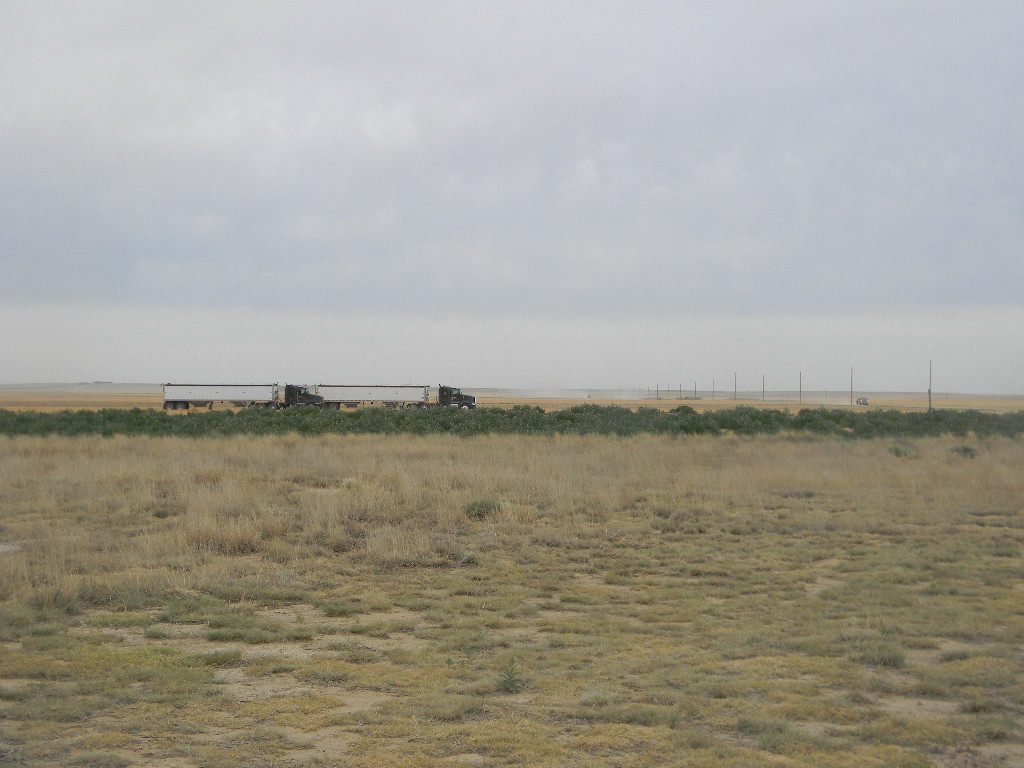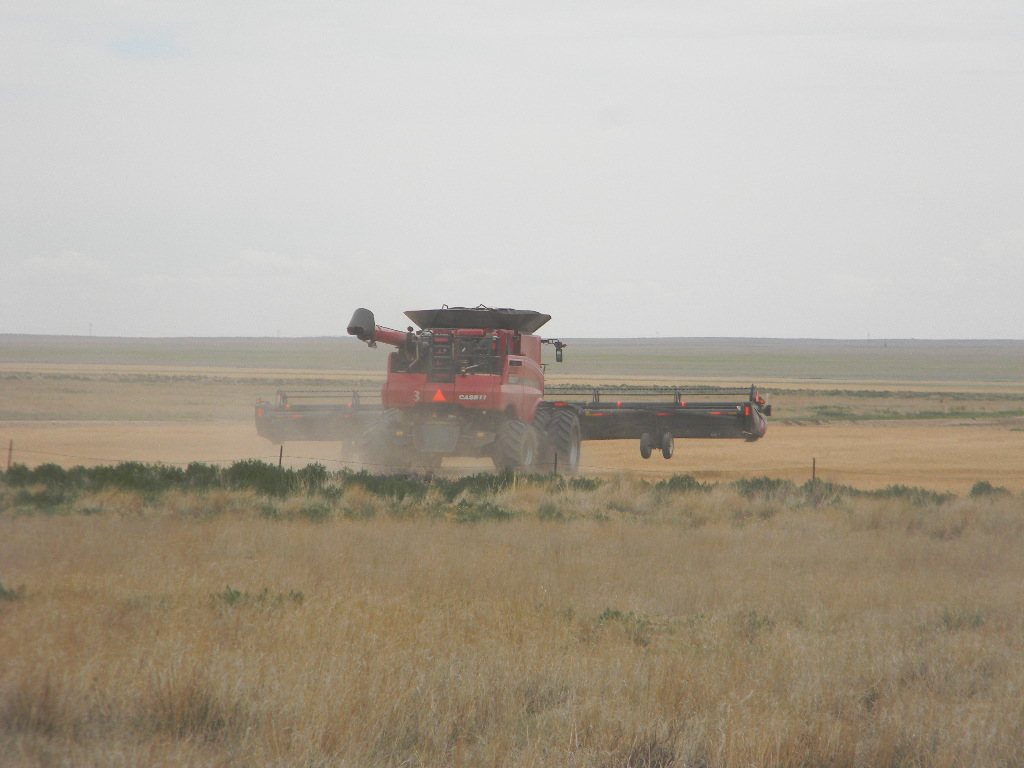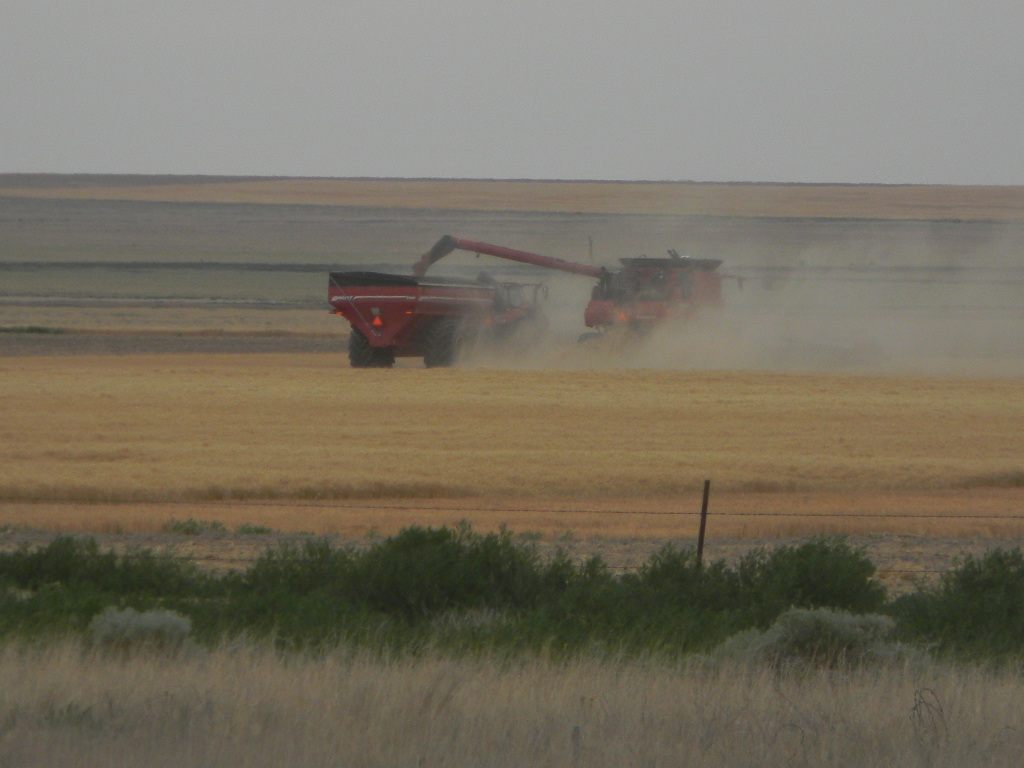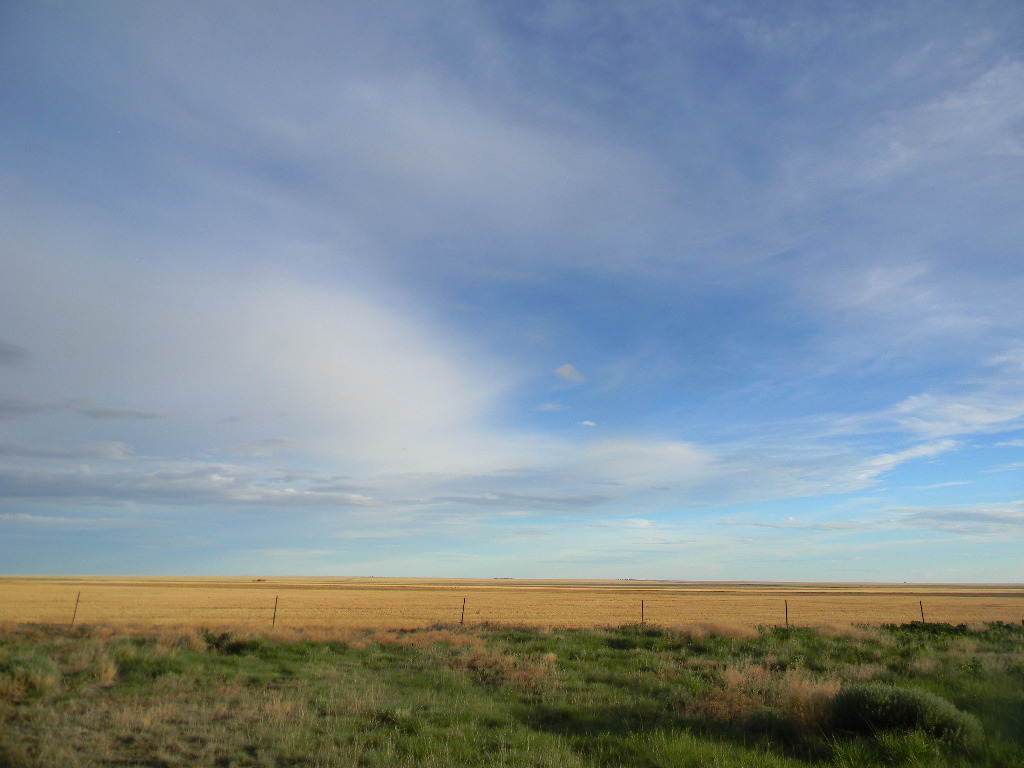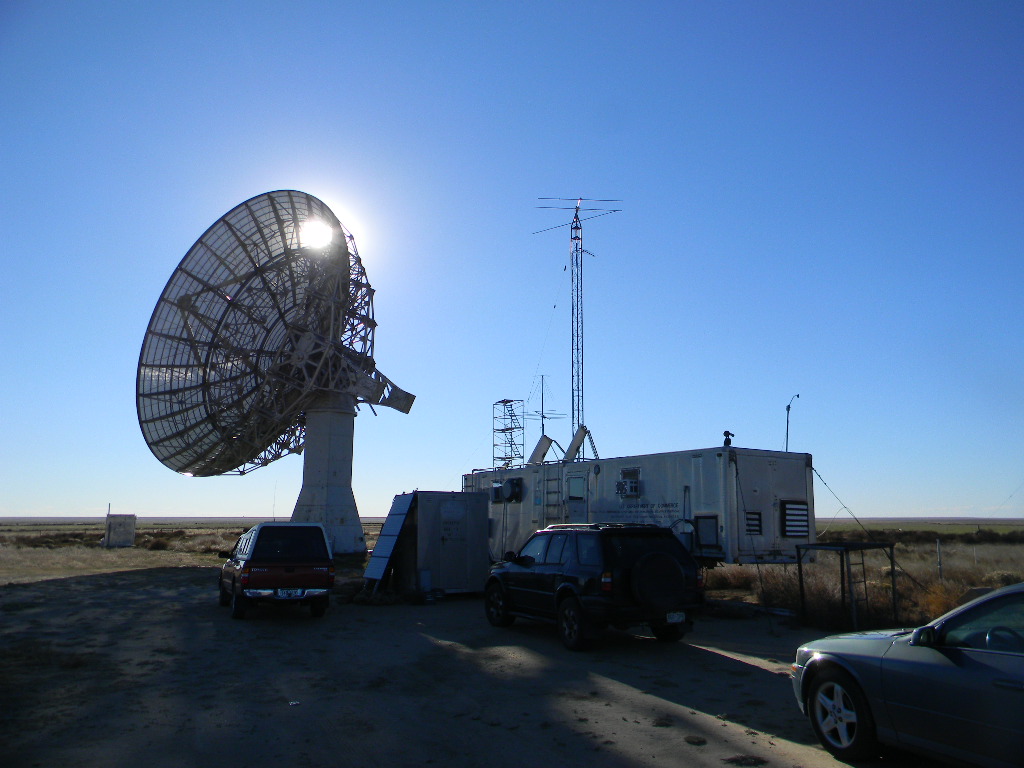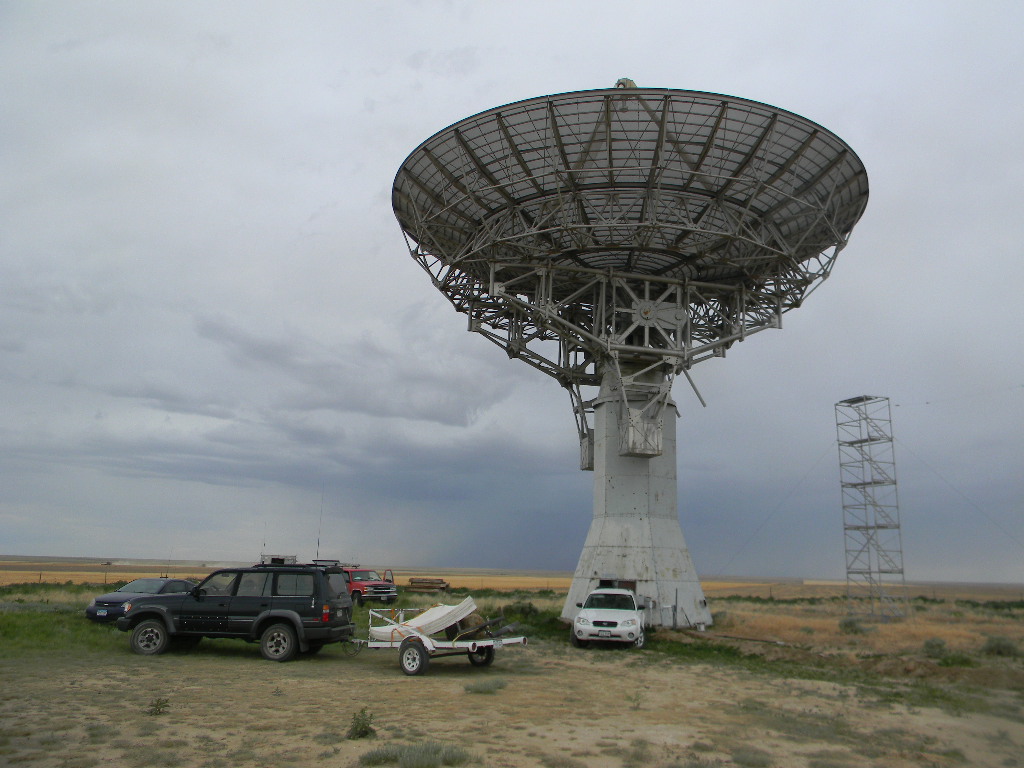Tag: Plishner Radio Telescope Site work
Bob Haggart’s work building a new porch and stairway for the communications trailer
Bob Haggart N0CTV is working on building a new stairway and porch to the communications trailer at the radio telescope site. He started the work at home after taking measurements. Today he traveled to the site to continue the work. With him were his grandson Allen and Allen’s friend Ben. Bob writes:
“We arrived at 11 AM. Worked on the porch and covered the fan with 24″ X 24″ plywood. Ran out of time but did get the porch assembled and painted inside and out. The hand railing is only temporary and will finish next work day on the 17th.”
Bob’s work is replacing a small simple set of metal steps that has given us access to the communications trailer.
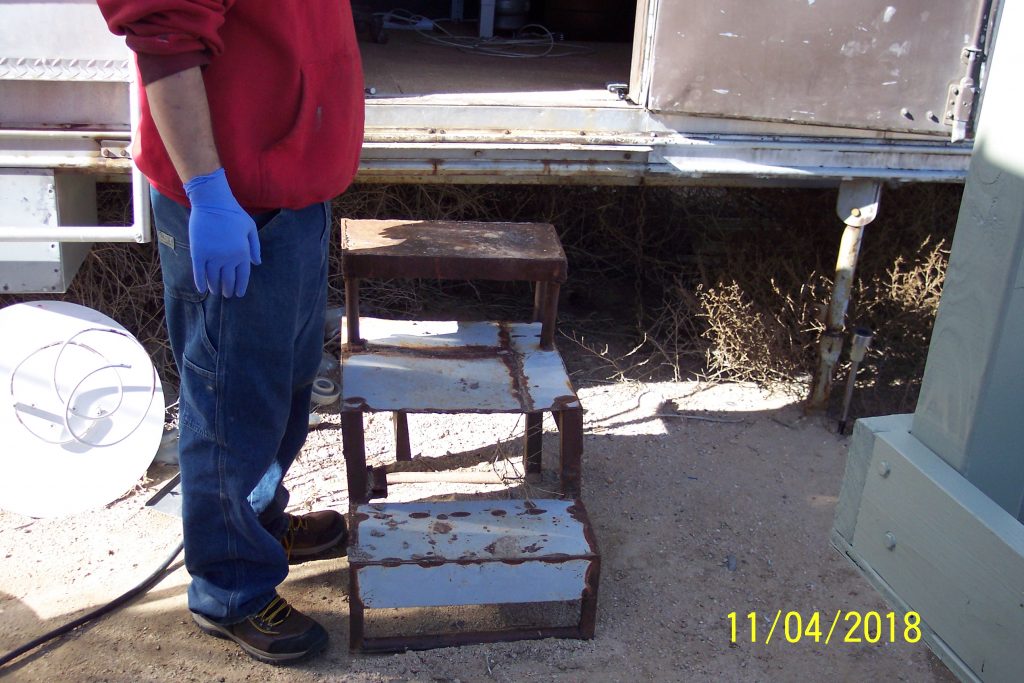
The new porch and stairway provide a great improvement.
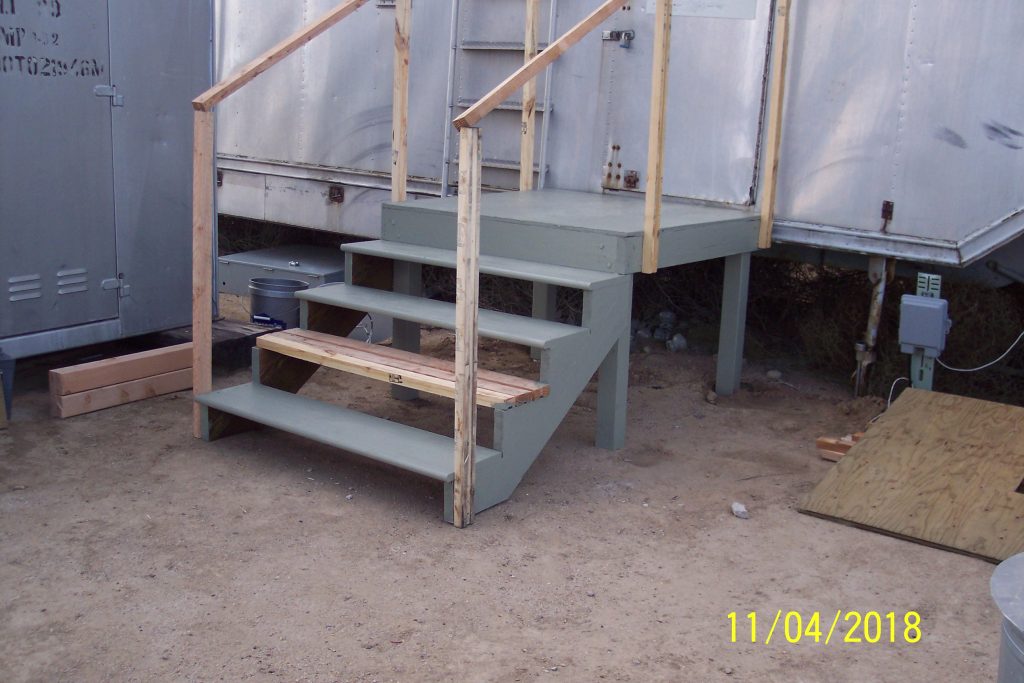
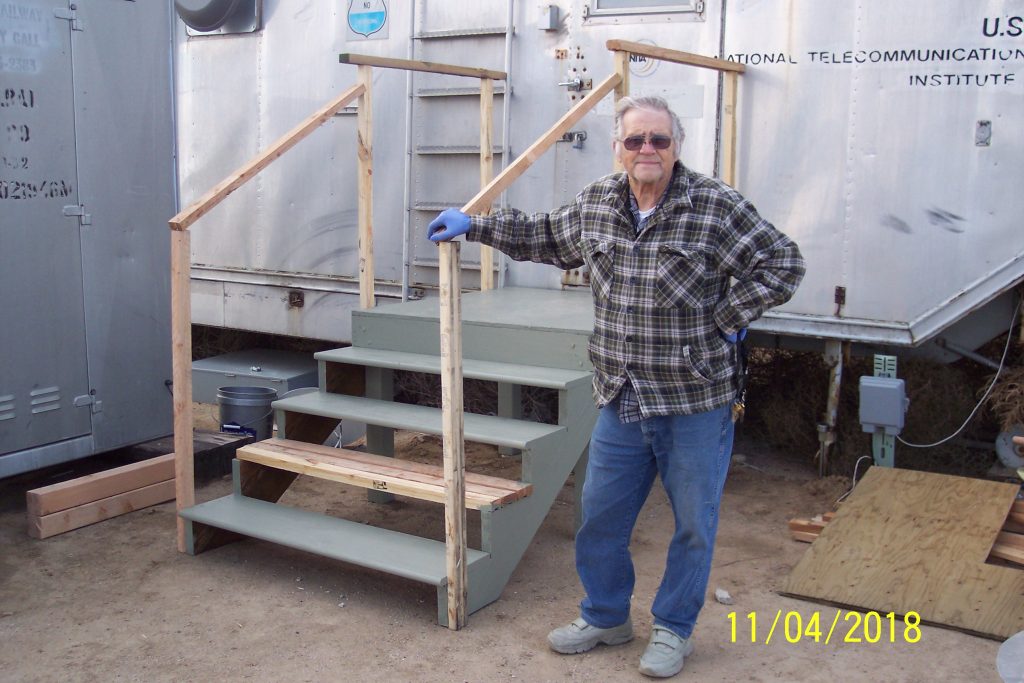
Thanks to Bob for all this work, and for improving the access to the communications trailer.
DSES Science Meeting, October 22, 2018
DSES Science Meeting 10-22-2018 Meeting Notes by Bill Miller
Location Rich Russel’s Residence, Colorado Springs
Attendance: Gary Agranat, Ed Corn, Floyd Glick, Glenn Davis, Steve Plock, Rich Russel, Tony Bigbee, Ray Uberecken, Dave Molter, Jon Richardson, Bill Miller
Attending Remotely via TeamViewer: Skip Crilly, Dayton Jones, Jamie Riggs
Last Trips: Oct 19 Observation Trip. Oct 20 Work trip for ED. Steve, Hans, Gary, Paul
Next Trips to site: The regularly scheduled 3rd Saturday of the month, Saturday Nov 17th. Observation the night before on Nov 16th
Meeting Schedule:
- DSES Technical and Operations Meeting- 2nd Monday of Every Month
- DSES Science Meeting – 4th Monday of Every Month
Accuracy: The notes for this meeting may be out of order. This was done to group the discussion into subjects for better clarity and continuity, so they are not true chronological minutes. As always if I have misstated, omitted or misrepresented anyone please feel free to correct me WKM.
Agenda and Notes
Ray Uberecken has his mount ready to install a 12 ft dish with capability up thru the KU band. He needs to move the dish from the KCME radio station to his site in Payton. The dish F/D ratio is the same as the 60 ft Haswell dish, so the 12 ft dish could be used to prototype feeds and receivers for the Plishner site. Ray would like some volunteers from the DSES to help move it next Sunday the 28th at 10AM. (Note: Recent change of plans. Ray will hire a crane to pick the dish out of the KCME yard enclosure before disassembly. This is currently scheduled for 7 AM Saturday, November 10th.) He could use some volunteers, power drills with sockets and a trailer. KCME is at Fontanero and 1921 N. Weber in. Bill will send an EMAIL out to the group.
Once the dish is in place the first thing that Ray will install is a Dicke Switch.
Ray also wants to know if we want to use the 8 channel UHF remote at the site for reset and control of the systems. We have not been using it, but that is available and installed in the communications trailer rack and can be commanded remotely from Ray’s residence.
Ray has also started his optical observatory with 8 inch Celestron and a good refractor at his residence.
Dr. Rich Russel reviewed his new Radio Astronomy Guide Rev. 3.
The RA/Dec of many of the objects are from both celestial coordinate year 1950 epoch and year 2000 epoch, so needs updating.
The output of the SpectraCyber is in volts and a translation to Jansky is needed.
Rich and Gary observed a number of sources on the Oct. 19th observation trip.
Some source positions were very good. Others were not. This may indicate a pointing error or other system issue.
They were getting a lot of clear source signatures but don’t know what many of them were. Rich would like to do cross galactic scans while changing declination to map the whole area in the future.
Cassiopeia A, Cas-A, was thought to be seen, but at a relatively low amplitude. Cas-A, being a 2200 Jy source it should have been clearly seen but they weren’t sure they had it.
Sagittarius A was strong and had the instrument setup with too high of gain, resulting in scale saturation.
Special sources 1 and 2 were studied.
The special source 2, a contact binary star is getting close to a supernova event in a few years, and we want to baseline it and get ready to observe the supernova emission.
To find objects Gary used the tables in Rich’s observing guide and in the Data Book “Astrophysical Data: Planets and Stars” by Kenneth R. Lang.
The V notch object that Tony studied was not tried in Rich and Gary’s session.
Galaxy Observations:
Rich and Gary also did an experiment to measure the hydrogen (HI) Line Doppler shift and therefor the velocity along the galactic plane. They were able to get reasonable hydrogen measurements of the galaxy’s rotational velocity at multiple points from the center out to the radius of the sun.
Rich plotted these observations and got a curve that is in the ballpark but a little different than the published data on similar measurements. This is the first time that the Galactic angular velocity measurement has been attempted with the 60 ft. dish.
See Dr. Rich Russel’s attached Science Meeting presentation for more detail on the site trip and the observations mentioned above.
DSES Science Meeting Presentation October 22, 2018 [Please click to view.]
Tony Bigbee also went to the site for the observing session last week. Tony installed onto the system after Rich and Gary had finished. He did not get the expected results on the RASDR 4 receiver when attached to the 60 ft. dish over the weekend. He thought that the issue may be with the pointing accuracy of the System 1 controller. We used System 2 at the open house when Tony had very good results but did not get the same on this last weekend’s observation session using System 1. Tony looked for the V notch absorption object and is using a new code to calculate the source amplitude. He did not get good results on this and suspects pointing error.
He calculated the curves for the open house and last weekend’s observations showing time and discovered that these are different indicating that something is wrong between the two.
Tony did a Mollweide projection plot like the one below. In Tony’s plot the green line is the meridian, the blue line is the galactic plane. The black X is the position of the telescope. See Tony Bigbee’s actual plot when he posts or sends it out.
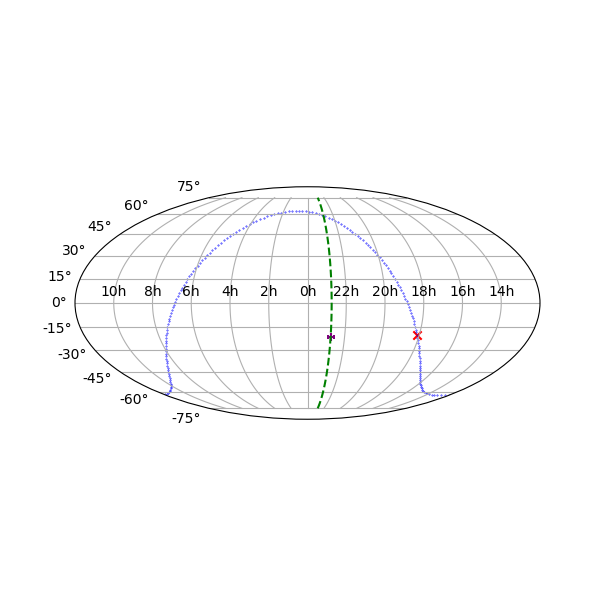
Rich suggests that anyone going down to observe should measure some of these same sources and get data to compare their results.
Skip Crilly says we have aligned NRAO 5690 at Greenbank and Haswell sites three times using the System 1 controller and it seems to be positioning correctly. Steve can do an additional observation next week, Tuesday and Wed and verify the alignment.
Another difference from the open house observation was that Steve Plock added the alternate cavity filter configuration.
As mentioned previously the coordinates of some of the sources are from celestial coordinate year 1950 epoch and year 2000 epoch so may be different positions now due to precession and galactic movement. A mathematical correction to the coordinates may be required to make an accurate set of coordinates for the current date. However, the small difference afforded by this is probably within the capture angle of the dish.
Glenn Davis says that his NTP time sever may be useful to improve the accuracy of the pointing systems.
Bill Miller said that the System 1 controller may still have a discontinuous elevation reading error. This was seen previously this summer and has not been fixed. This could contribute to a pointing error and inaccuracy on some coordinates.
Additional Considerations:
Anyone going to do observations at the site should try to replicate the studies of the observation guide and use the Observation Checklist to make their session useful and comparative.
Currently the LMST is close to local time, and so one needs to consider this and observe in the evening instead of afternoon.
See the back of Rich Russel’s observing guide for dish rules and limits. An observation data sheet and suggestions are available in the back of the guide as well.
We need a list of some calibration sources to start all observing session with, to be sure that the pointing system is working properly and that it isn’t broken with new SW drops. Also, we hope the voltages we measure from calibration sources (with known Jansky levels), will enable us to derive the Janskies of other objects we wish to observe. Janskies are the measure of the flux density that the antenna receives.
Three papers have been accepted in the next SARA journal.
“The Deep Space Exploration Society 2018 Perseid Meteor Shower Open House”. By Bill Miller, Gary Agranat. Deep Space Exploration Society.
“SpectraCyber Neutral Hydrogen Measurements using the Deep Space Exploration Society 60 – foot Antenna System“. By Richard Russel D.Cs., Ae.E.; Gary Agranat. Deep Space Exploration Society.
“Dark HI Cloud Observation using the Deep Space Exploration Society Plishner 18 – Meter Dish with the RASDR4“. By Tony Bigbee, Richard Russel, Steve Plock. Deep Space Exploration Society.
Skip Crilly discussed his new 28 ft. antenna that has a 5 pixel or 5 separate antenna segment feed and is mounted on a cargo trailer but will be used mostly for SETI. The antenna may not be large enough to observe the strange signals we have seen. File size is one challenge since it is inversely proportional to the gain and noise ratio.
Meeting was adjourned after much secondary discussions not captured here.
Old 9/24/2018 Agenda and Notes from last science meeting:
- Glenn Davis proposes a graphical user interface called Astro Guide that would allow better guiding and tracking of radio sources.
- Rich’s presentation and overview of the radio astronomy guide
- Started with Floyd’s list
- Added the 1420 MHz sources from the book “Tools of Radio Astronomy” by K Rohlfs and T Wilson.
- Added the hydrogen measurements from K5SO, Dr. Joe Martin who has provided signature images of the objects.
- Gary, Jay Wilson, Rich and Steve all went to the site on 9/22 and did observations using the 60 foot dish.
- Used Spectra Cyber
- Used system 1 pointing
- Used the new setup with the cavity filter
- Limit switches are set at +/-15 ether way of north. CCW to 345. CW to 015.
- Gary got great pictures of the event.
- Need screen print capability to capture the Spectra Cyber parameters display.
- The Spectra Cyber SW is easy to take the data and use it.
- Need a Lap Top with a com 2 serial port to attach the spectra cyber. This is difficult because most of the Serial to USB port adapters don’t want to set for Com1 or Com2.
- Need to do calibration sources before and after observation of an observed object and keep all settings on the Spectra Cyber the same.
- From Tony, “To avoid problems of solar interference all observations were made between sunset and sunrise. Most scans were taken with the telescope on the meridian.” Galt and Kennedy, 1968, ‘Survey of Radio Sources Observed in the Continuum near 1420 MHz, Declinations —5° to +70°’ http://adsabs.harvard.edu/abs/1968AJ…..73..135G
- Rich presented a number of plots from their observations. See Rich’s report.
- The scan across the galaxy were at one RA. The radio hot area was offset from the optical.
- The galactic rotation rate was also observed.
- Got a lot of raw data, learned how to catalog it and analyze it.
- The calibration sources did not show any signal above the noise.
- Got good data for Sagittarius A, SAG A.
- 3 Papers have been submitted for the SARA Journal.
- The Western SARA conference is in Boulder in March.
- Next Observation Trip. Need a couple of nights.
Plishner Site Report for the Weekend of October 19-21, 2018
This is a summary of our activities at the Plishner radio telescope site during the third week of October 2018. Steve Plock, Ed Corn, and Gary Agranat contributed to this report.
Participants this weekend were Gary Agranat, Paul Berge, Tony Bigbee, Ed Corn, Hans Gaensbauer, Dave Molter, Steve Plock, and Rich Russel.
Our plan for the rest of the year is to work at the site during the third weekend of each month. The Friday evening is devoted to astronomical observing, and the rest of the weekend is then devoted primarily to infrastructure and equipment work.
60-foot Antenna Observing, by Gary Agranat, WA2JQZ
On Friday afternoon and evening Rich, Gary, and Paul did 1420 MHz neutral hydrogen observing with the 60-foot antenna. The primary observing goal was to take regular measurements of the hydrogen signal along the Milky Way galactic plane at 10 degree intervals, from the galactic center to about 110 degrees (a little more than the first quadrant). The Doppler shift of the hydrogen was measured at each 10 degree point. From that, Rich later used some basic geometry to derive a velocity and distance from the galactic center for each measurement. A second goal was to observe several known, strong galactic radio sources that could be used in the future for calibration of our observations, and also to see if we are capable of observing those sources in a consistent way (without unknown biases). A third goal was to observe additional galactic sources as targets of opportunity, to see how well we do, and to also see what problems we hit.
Galactic plane observing started at about 5 pm local time, when the galactic center in Sagitarius had risen high enough in the sky for us to observe. The galactic plane and most of the other observing were done with the 60 foot antenna pointed along the meridian (180 degrees azimuth to the south and zero degrees to the north), in order to eliminate the Earth’s rotational motion in the Doppler shift measurements. We observed until about 10:30 pm, when the team was then quite tired. To warm us up during the evening, we made a batch of hot apple cider.
Details of the observations and results were discussed at the science meeting on Monday October 22nd, and those will be covered in a separate post.
– Gary WA2JQZ
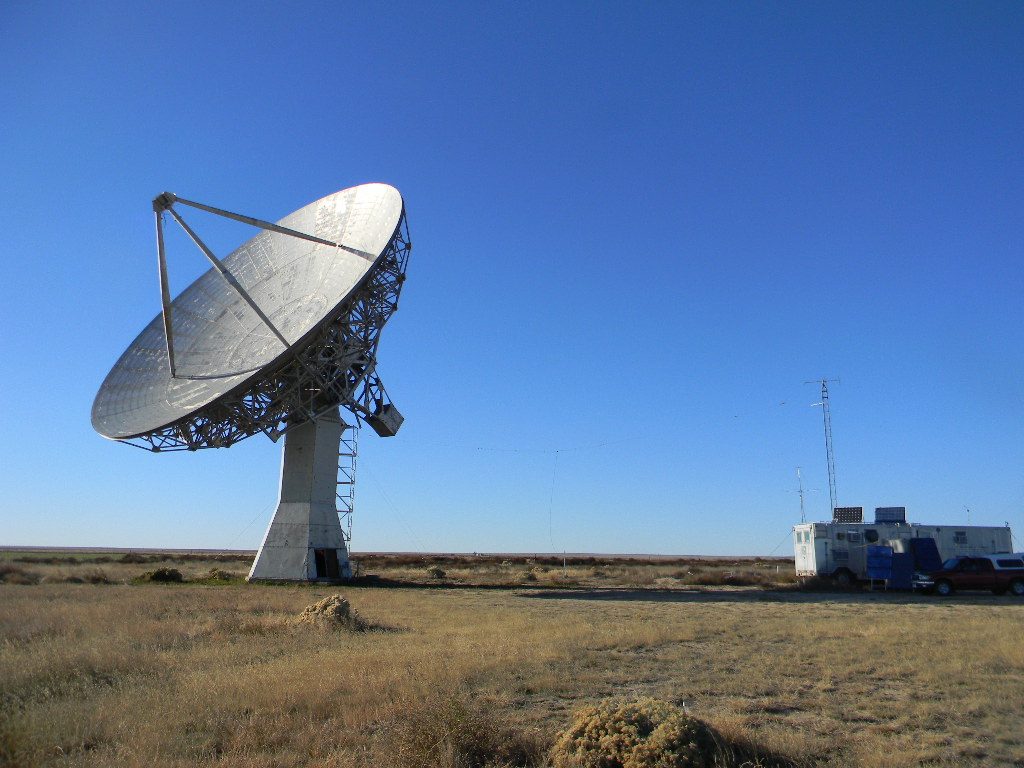
We’ll continue with the discussion of the weekend infrastructure work.
Saturday Infrastructure Work by Ed Corn, KC0TBE
Our first order of business was to re-service the toilet and spare in the outhouse. They now both have RV antifreeze for winter. Next installed was a portable heater for winter operations and I labeled all the breakers in the out house. I then labeled the doors with instructions for emergency exit and the safety pin for privacy at the main door.
With the help of Gary, Hans, and Paul we have the first 3 tower sections in place at the bunker, along with the first set of guy wires. [More about the tower below.]
-73’s Ed KC0TBE
DSES Site Work Report by Steve Plock KL7IZW, DSES President
Paul Berge worked on Friday, Saturday and Sunday. Because he travels from Lyons, Co. he prefers to maximize his efforts each visit. Also the weather window for the year is closing. I attempt to support his efforts as best as I can. Paul provided support for Rich Russel’s data acquisition which included galactic Doppler measurements. The team knocked off before midnight. Results have already been detailed in the Science meeting on 22nd of October.
On Saturday Ed installed a heater in the outhouse, winterized the RV toilets, and labeled the outhouse breakers.
During Saturday afternoon Hans, Ed, Paul, Steve and Gary all worked together to erect the new communications tower. The first set of guys were finished at 23 ft. by Ed Corn doing all the climbing. The majority of the rest of Saturday myself and Paul spent evaluating the elevation limit switch operation, including testing complete functionality with fault clearing via the built in override capability.
Later that day, Tony Bigbee showed up, and Paul and Steve supported subsequent hydrogen observations using the RASDR4 receiver.
The majority of Sunday was consumed by lubrication of the dish and adjustment of the azimuth drive chain. I also installed the conduit in the elevation bulkhead so that Bill Miller can complete his synchro wiring project.
Sunday Dave Molter worked into the night using the 500W floodlights and mixed over 1000lbs of concrete to try to prevent continued erosion in the ramp area. A big thanks to all who participated in this cooperative effort.
– Submitted by: Steve Plock, President DSES
Photos by Gary, from Friday and Saturday:
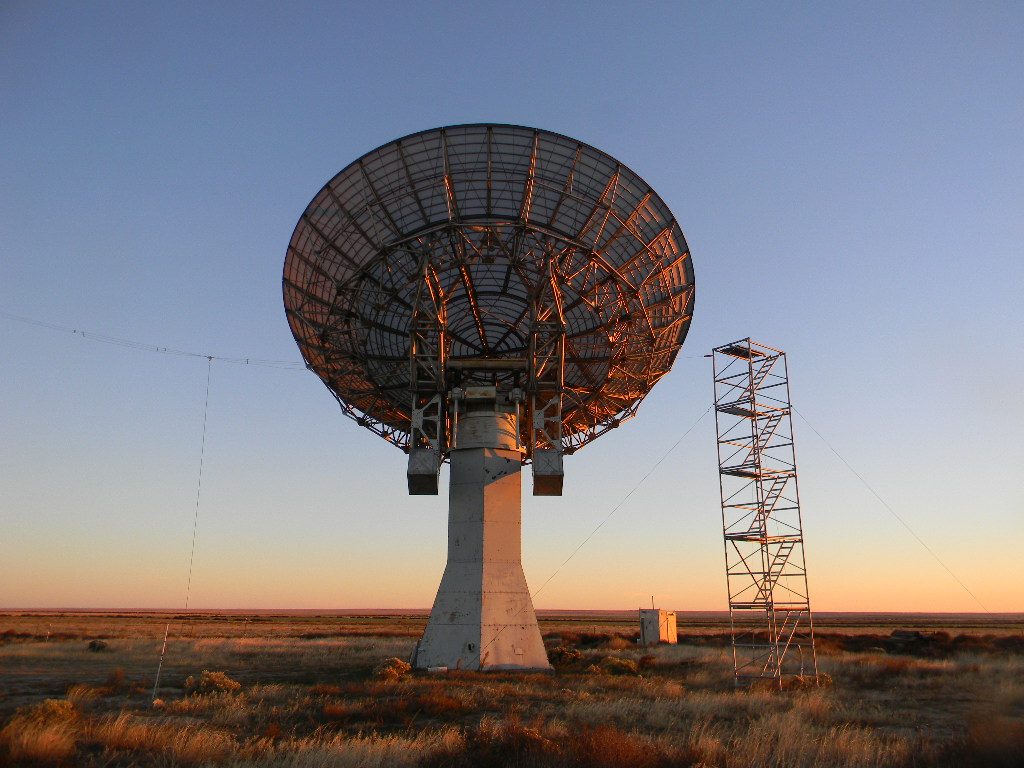
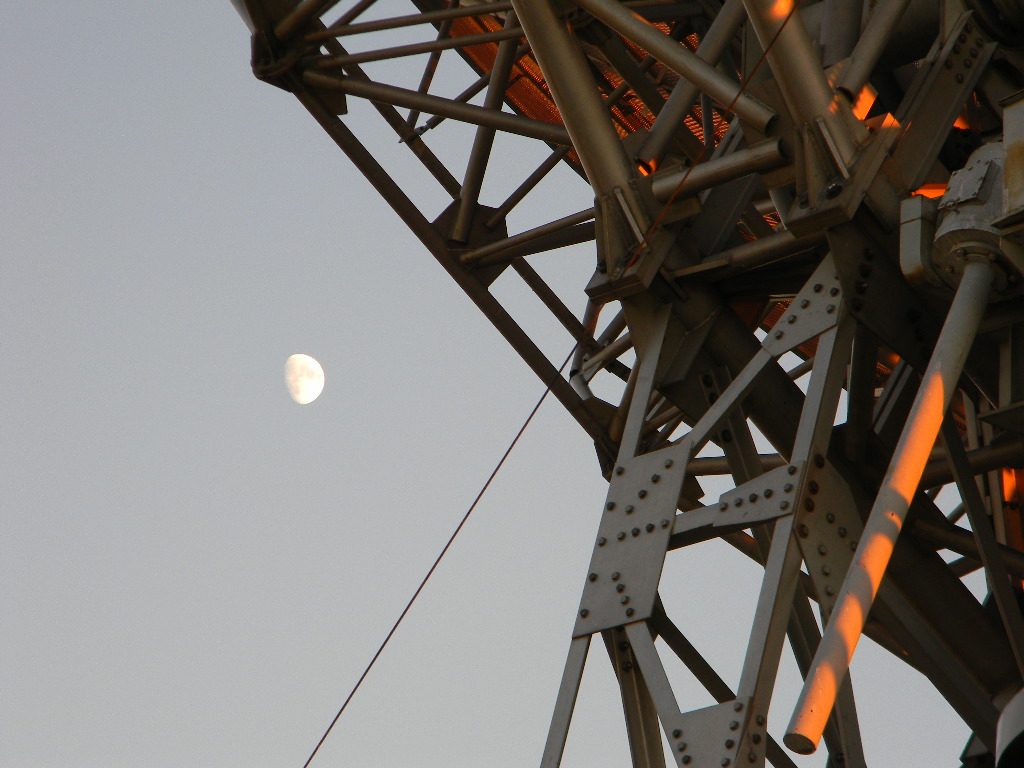
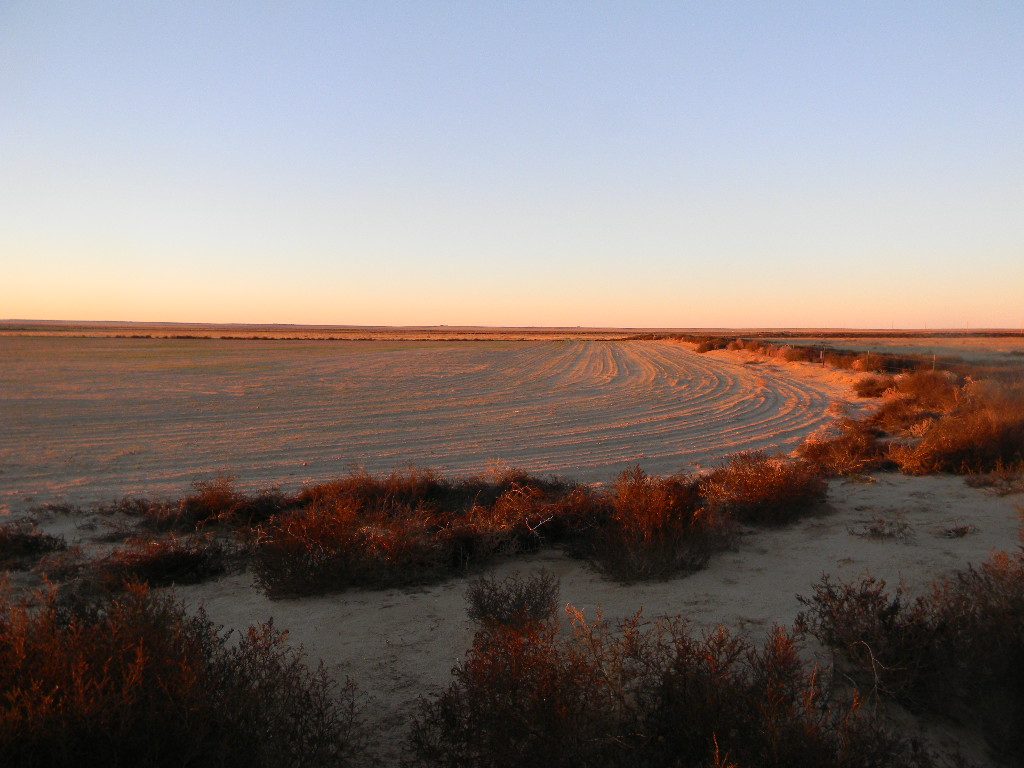
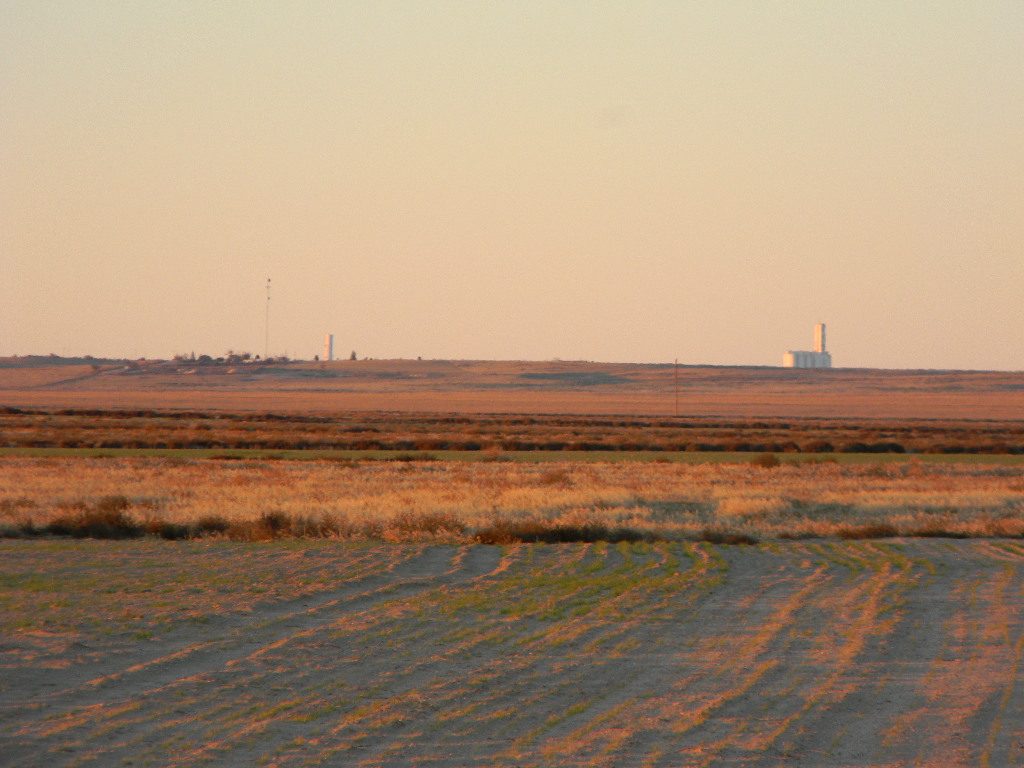

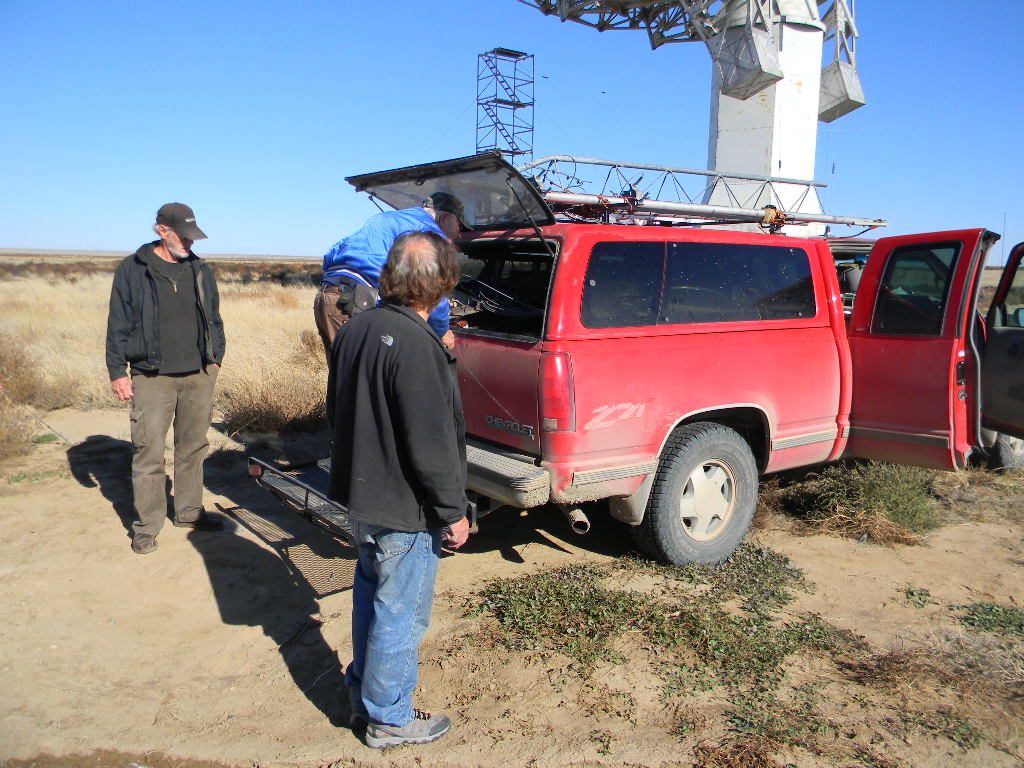

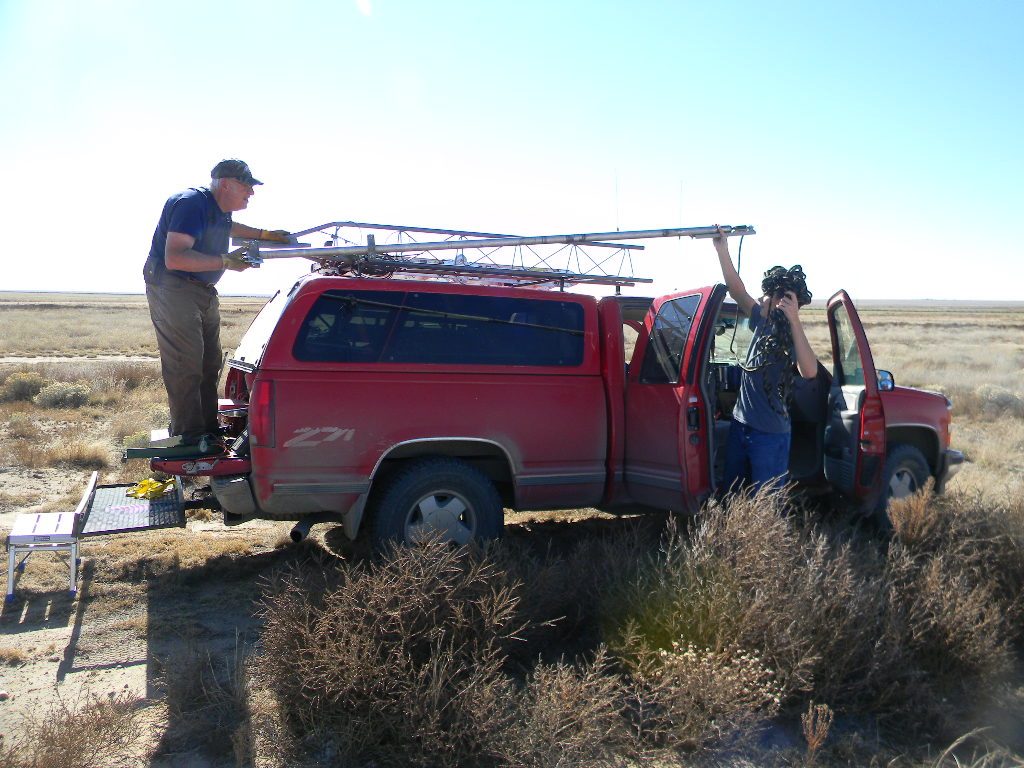
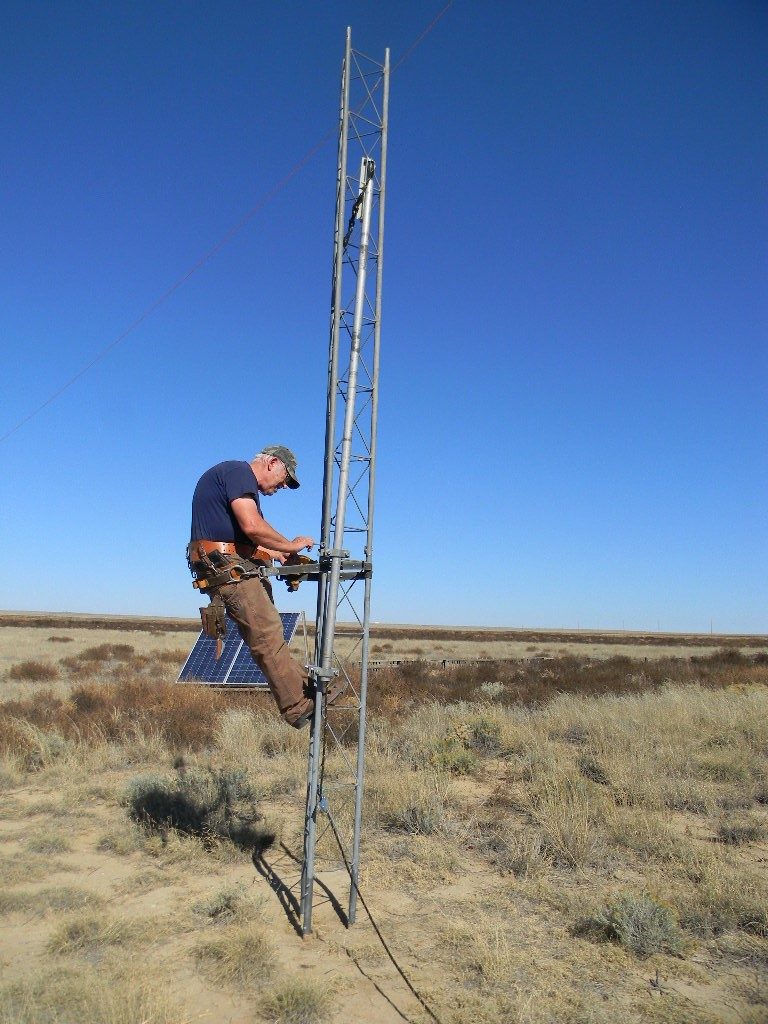
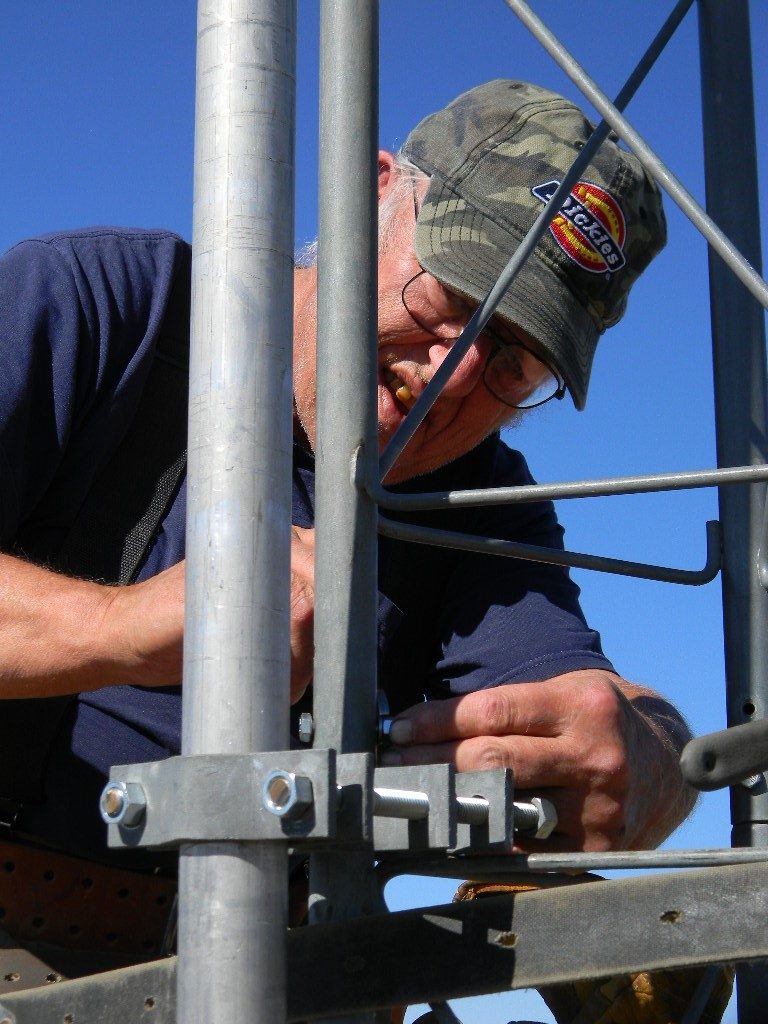

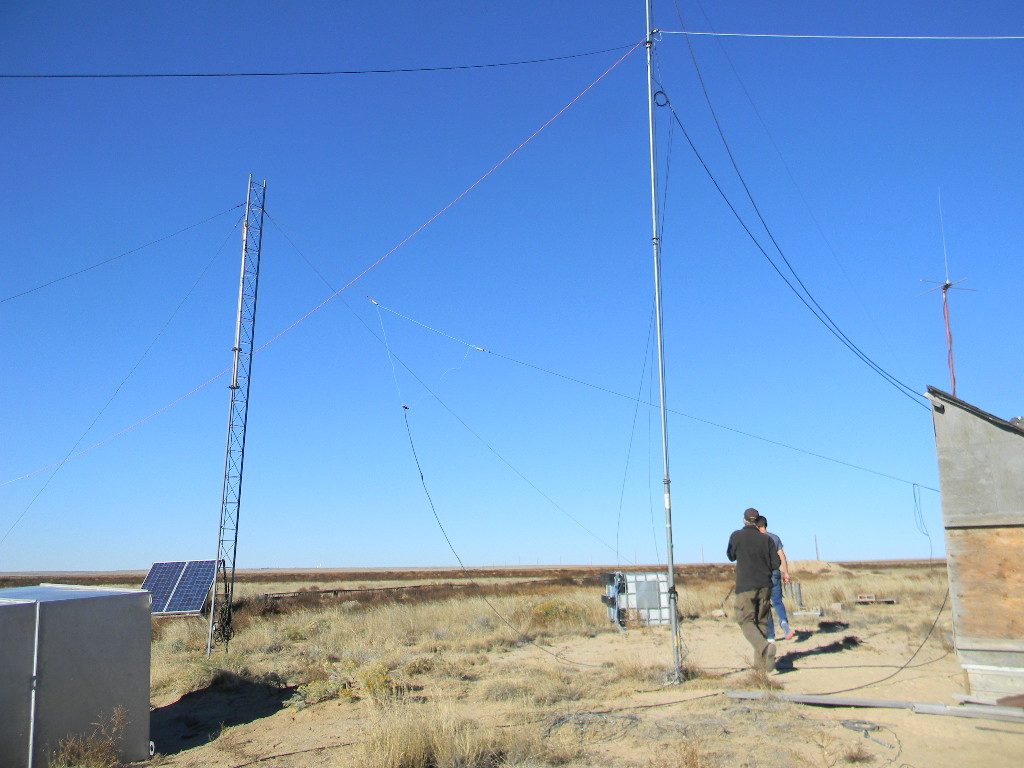
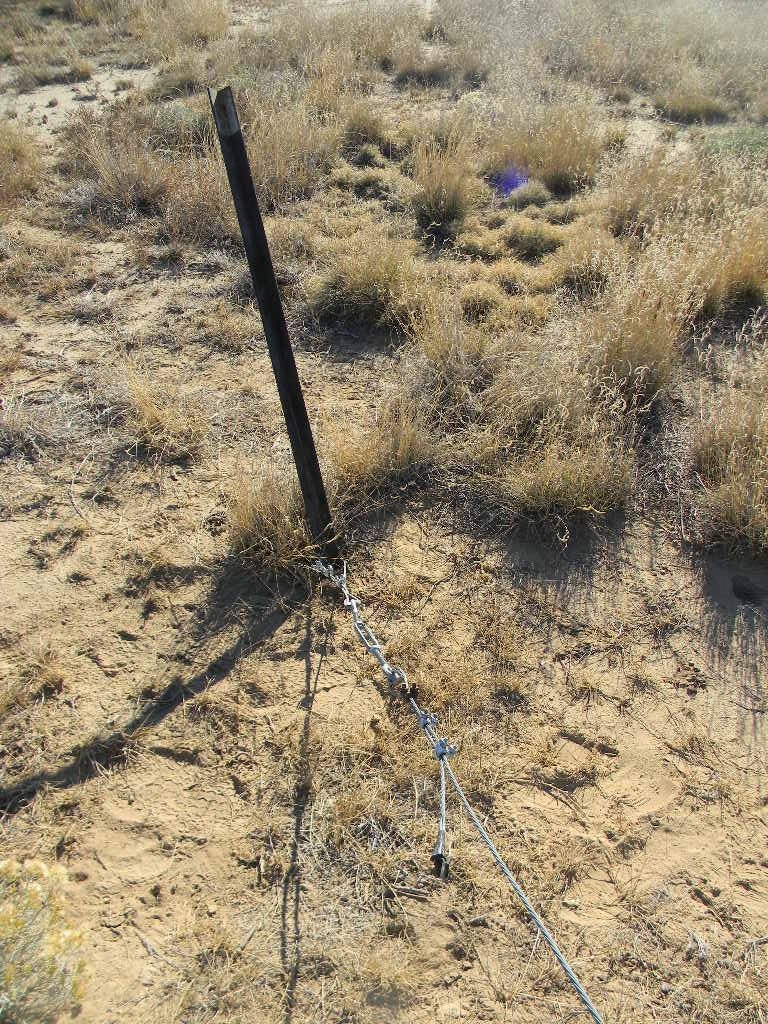

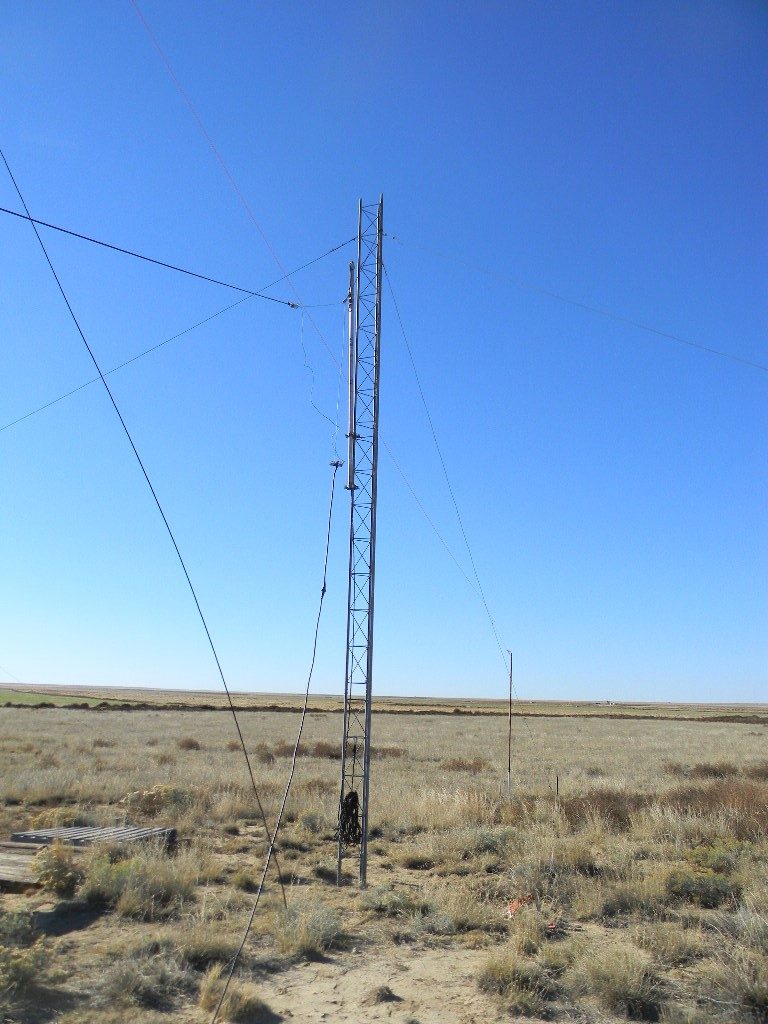
DSES Plishner Site Work Trip Report September 14-16, 2018
Here is our report of our work trip at the Plishner radio telescope site in Haswell, on the weekend of September 14-16, 2018. Opens as a PDF file. Illustrated with photos.
DSES Plishner Site Work Trip Report September 14-16, 2018
By Bill Miller and Gary Agranat.
Radio Telescope Site Work & Science Trip – August 25, 2018
Participants: Steve Plock, Ed Corn, Rich Russel, Dave Molter, Gary Agranat.
Summary and photos by Gary Agranat.
We worked at the Plishner Radio Telescope site on Saturday August 25, 2018. One motivation was to proceed with needed infrastructure work before the cold of winter returns. Another motivation was to follow up on the observations we made during the Open House with the 60-foot antenna. In addition, the antenna tuner for the bunker ham radio station was still not running, and needed to be checked. Here is a summary of what we did, with some photos.
1. Ed and Steve replaced the outflow hose from the ramp sump with one more durable (including durable against mice). Ed tested that the outflow did drain away from the ramp area. We placed a new aluminum manhole cover on the sump access (vs the original steel one), fabricated by Steve.
2. Ed moved the Internet hotspot to the bunker. The hotspot was used by Gary while testing and operating the ham radio station.
3. Dave brought 20 x 60-pound bags of cement, and used all of them to continue to repair/rebuild the ramp retaining wall. He made considerable progress extending the base of the wall. The higher the base of the wall reaches up the ramp, the less rain sediment will clog the sump pump. Dave stayed until late in the evening, until around sunset. Gary stayed with him and gave some help.
4. Rich brought the SpectraCyber 1420 MHz Hydrogen Line Spectrometer, and used it to continue to test the functioning and ability of the SpectraCyber together with the System 1 pointing system on the 60-foot antenna. Rich later showed Gary how to steer the dish antenna, and how to measure and record neutral hydrogen data. By the end of the day we located and measured several radio sources in the Sagitarius region. And we made a systematic scan almost perpendicular to the Milky Way galactic plane, in order to measure neutral hydrogen while pointing away from and in the plane. A more detailed discussion follows later in this post.
5. Gary tested the setup of the newly installed auto tuner for the FT-897 in the bunker ham station. With some adjusting and checking of cable connections, the tuner was found to be functioning OK. Gary took the opportunity to operate K0PRT in the QSO Parties this weekend for Kansas, Ohio, Hawaii, and for the US & Canadian islands, making about 30 contacts, on SSB and CW, on 40, 20, and 15 meters. Signal reports were mostly good, which seemed to indicate the combined FT-897 + tuner system is working OK. Gary wrote some Guidance Notes for using the tuner, and left those next to the tuner.
6. We received 20 QSL cards in the mail from the Open House special event station. Myron passed them on through Ed to Gary. Gary responded to all of them, and sent in the mail our QSL card responses to all by Monday.
Next are some photos of our work. Then follows a more detailed discussion about the SpectraCyber observations with the 60-foot antenna.
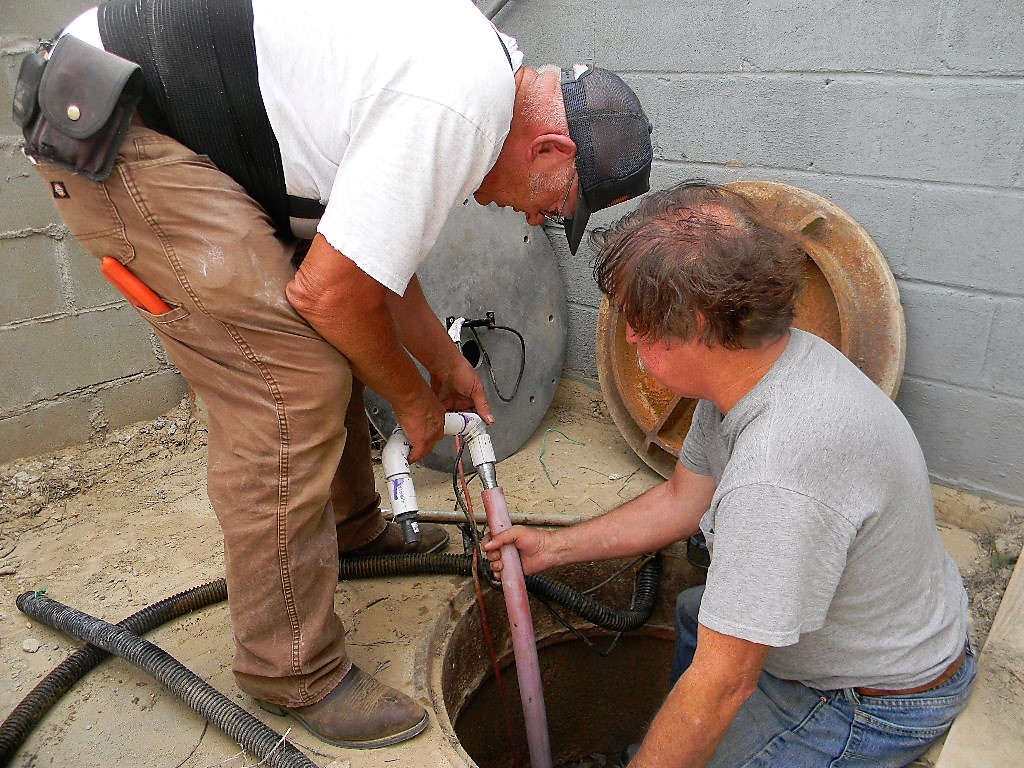
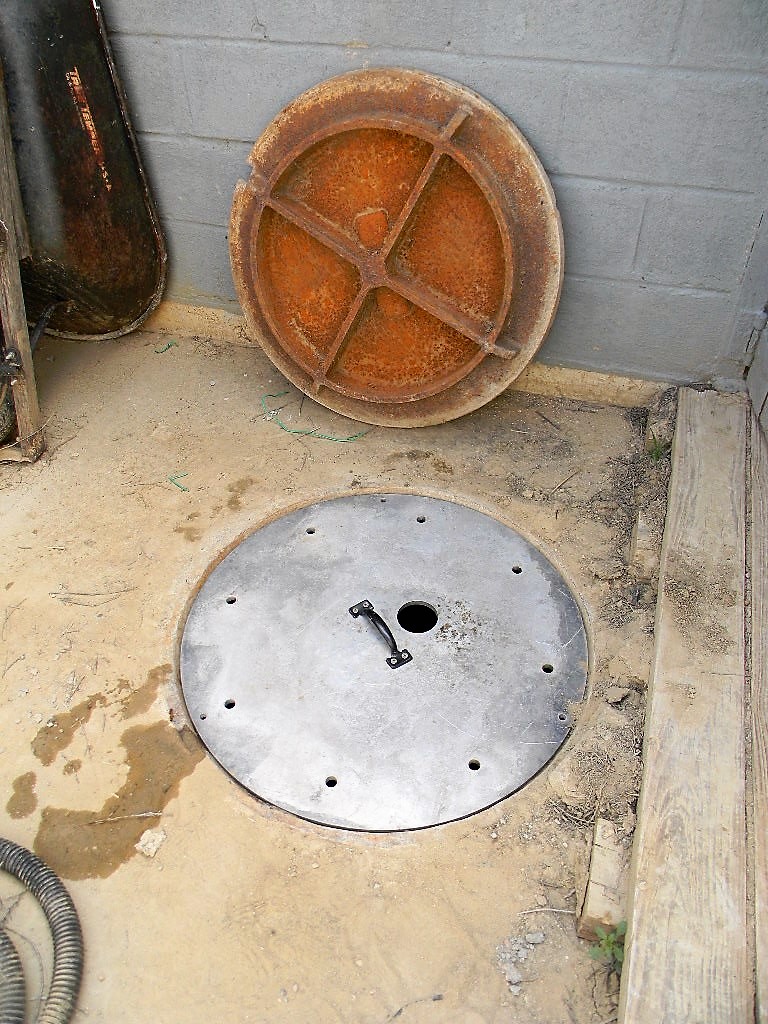
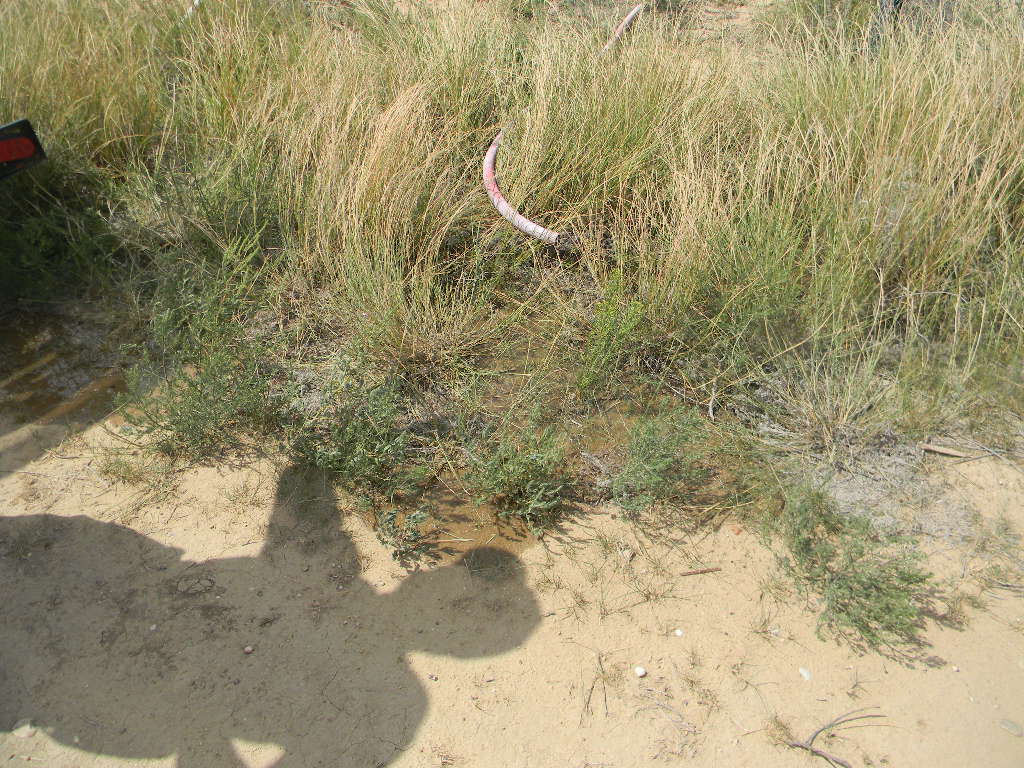
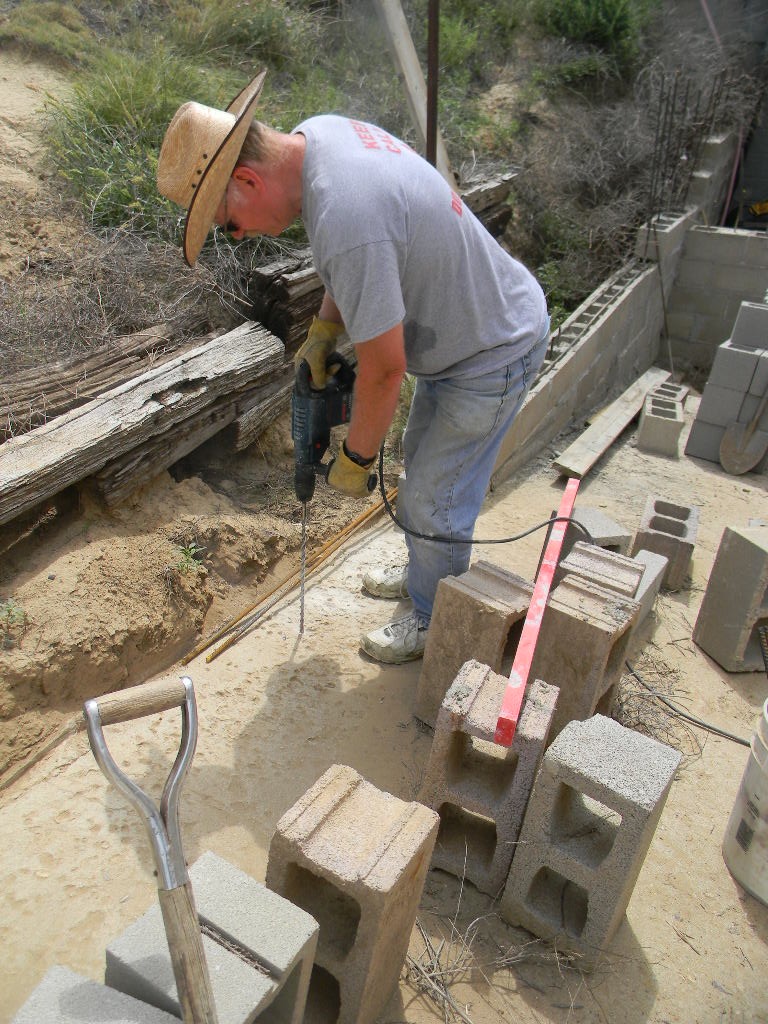
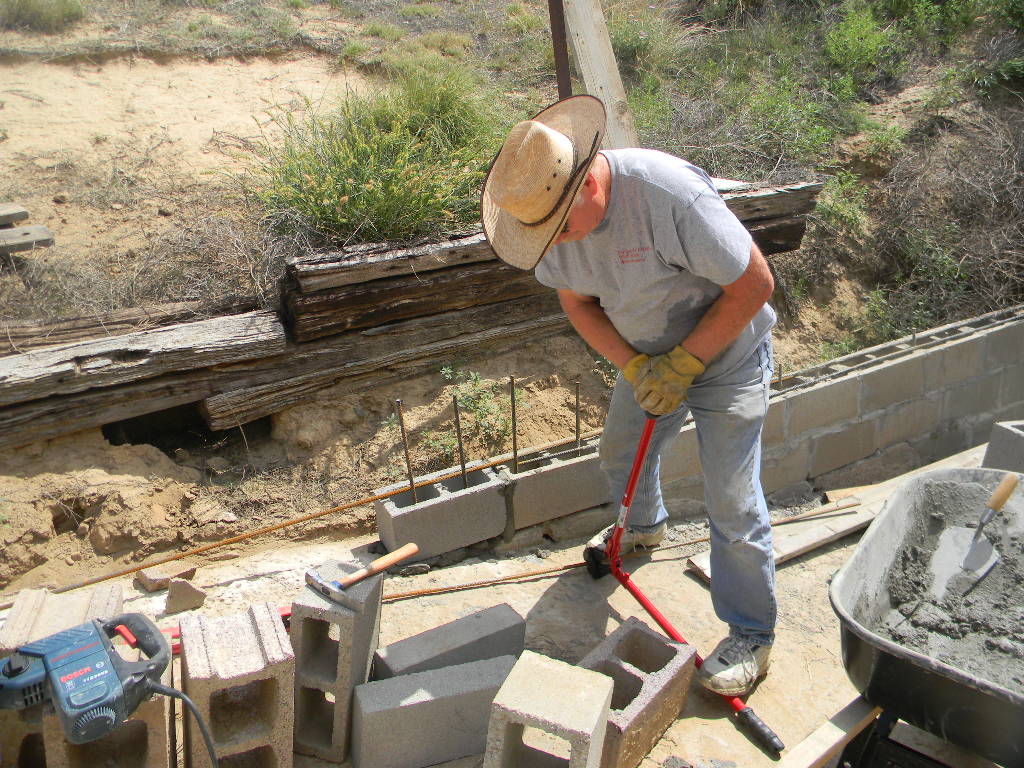
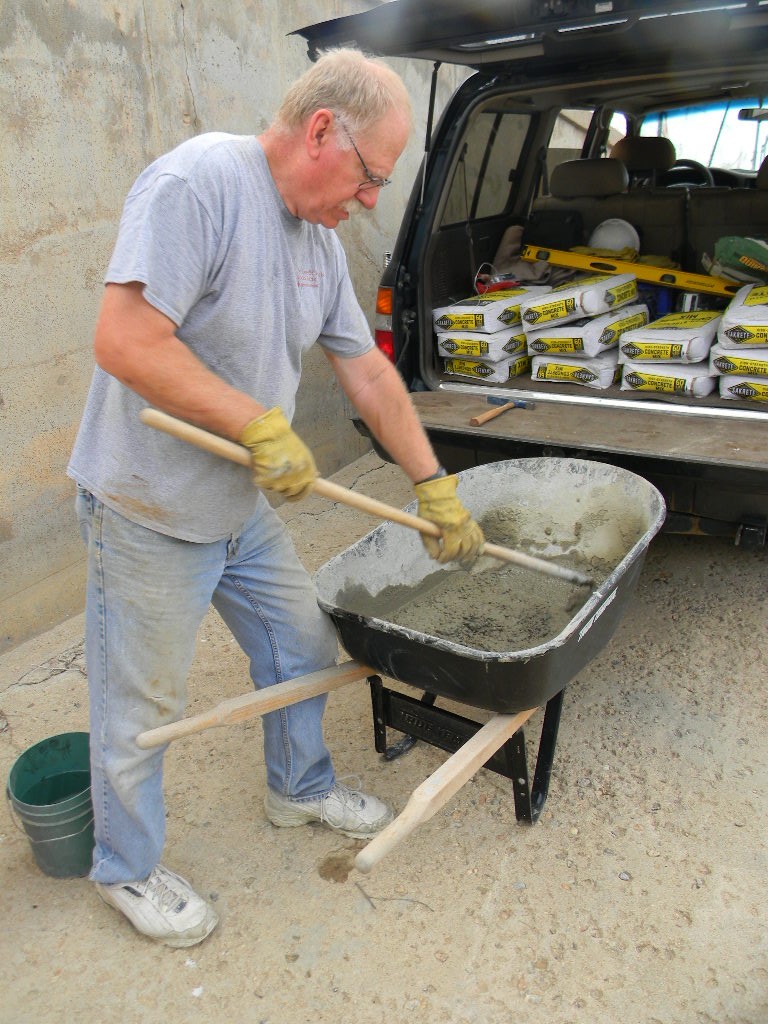
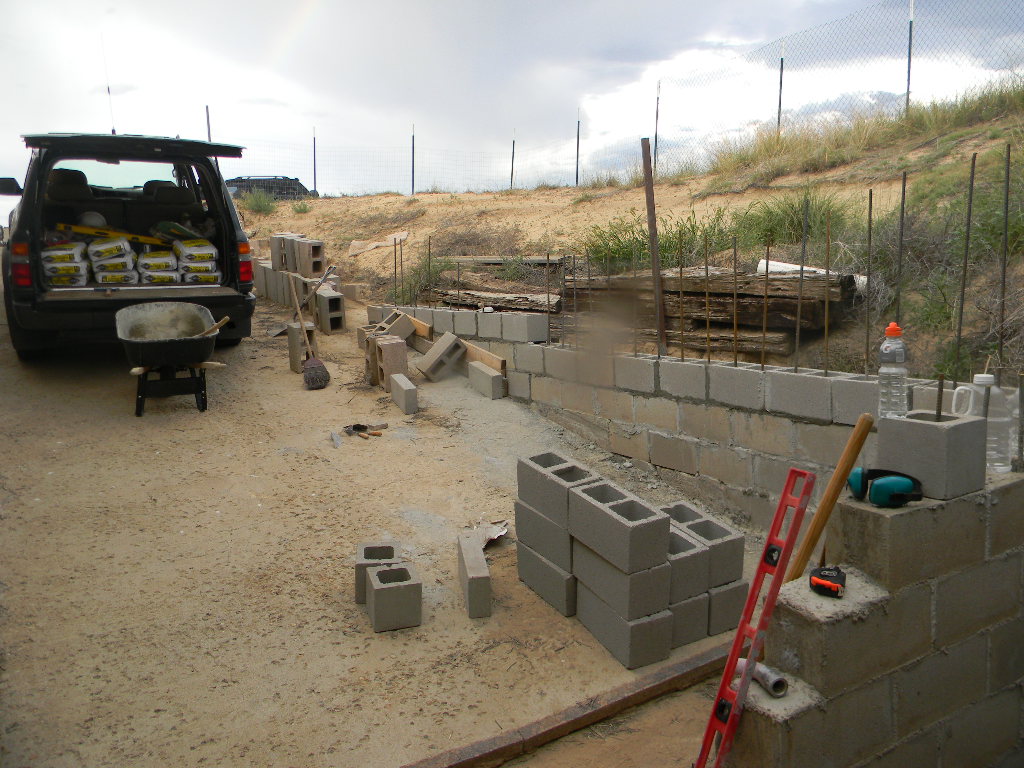
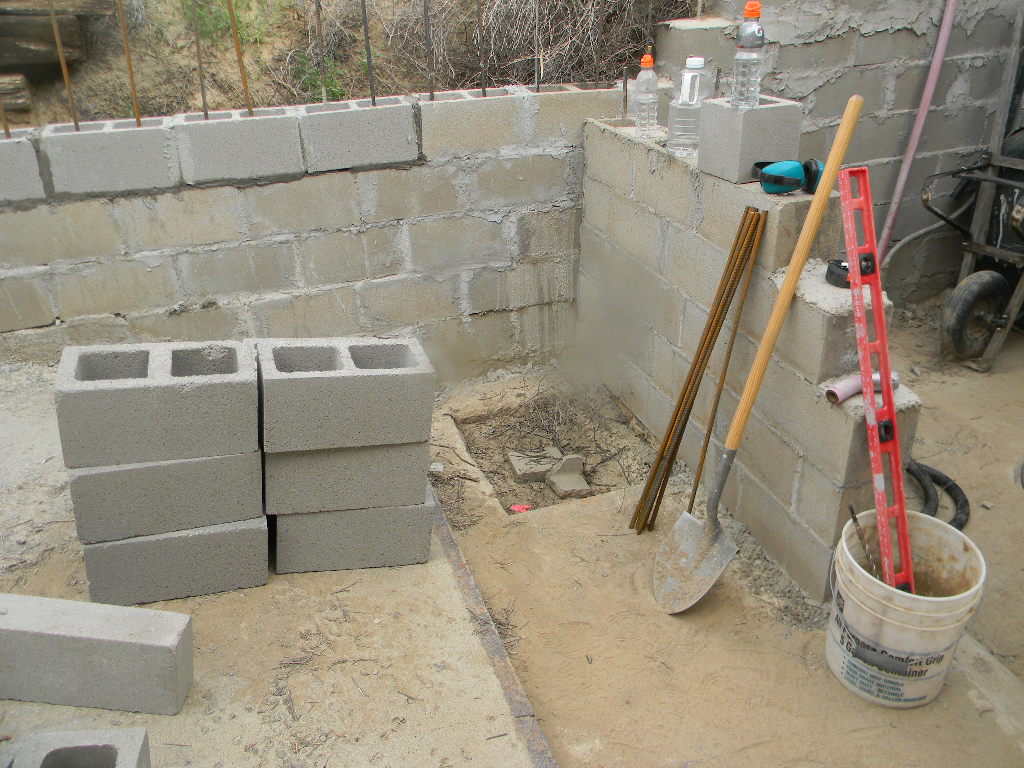
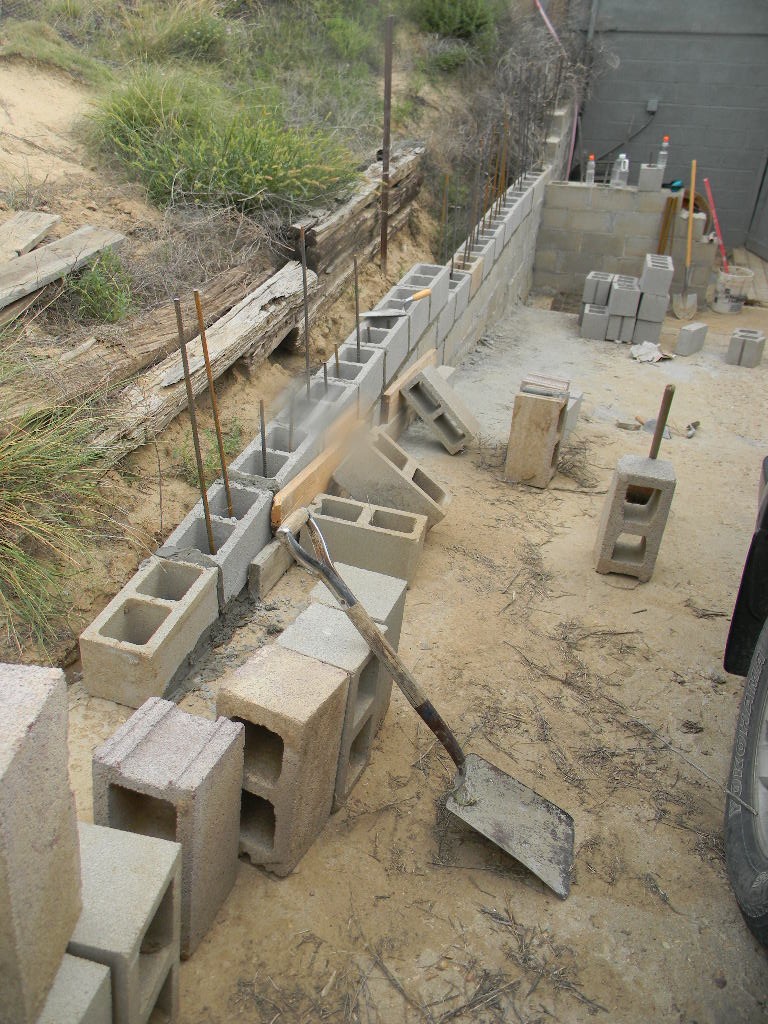
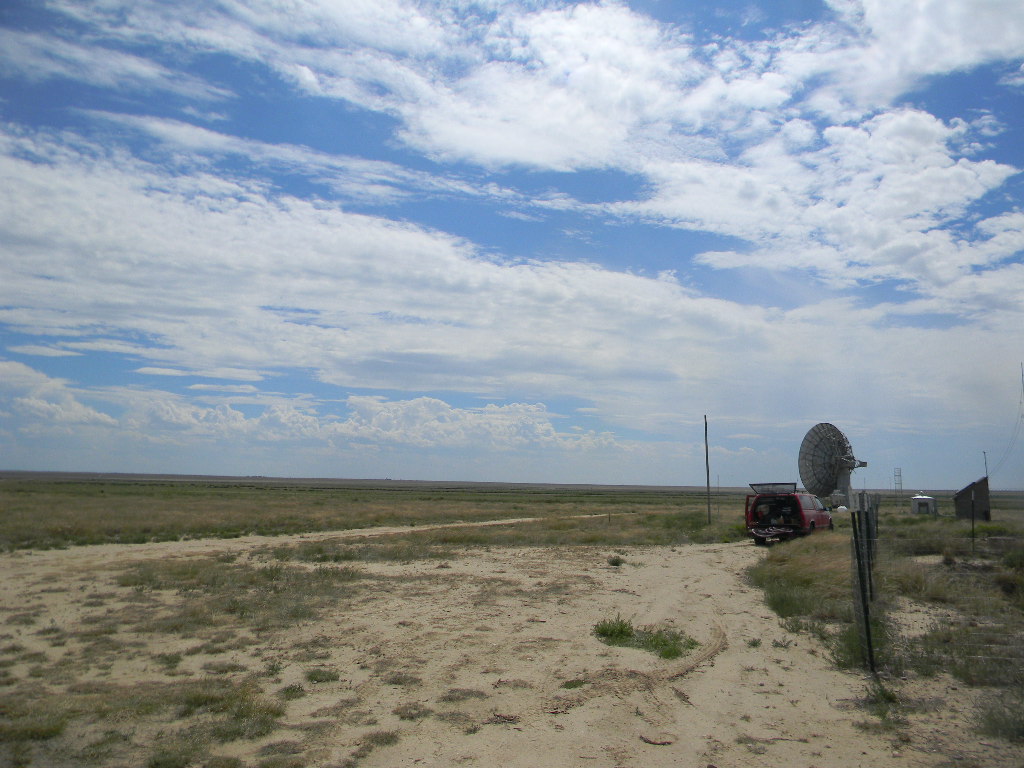
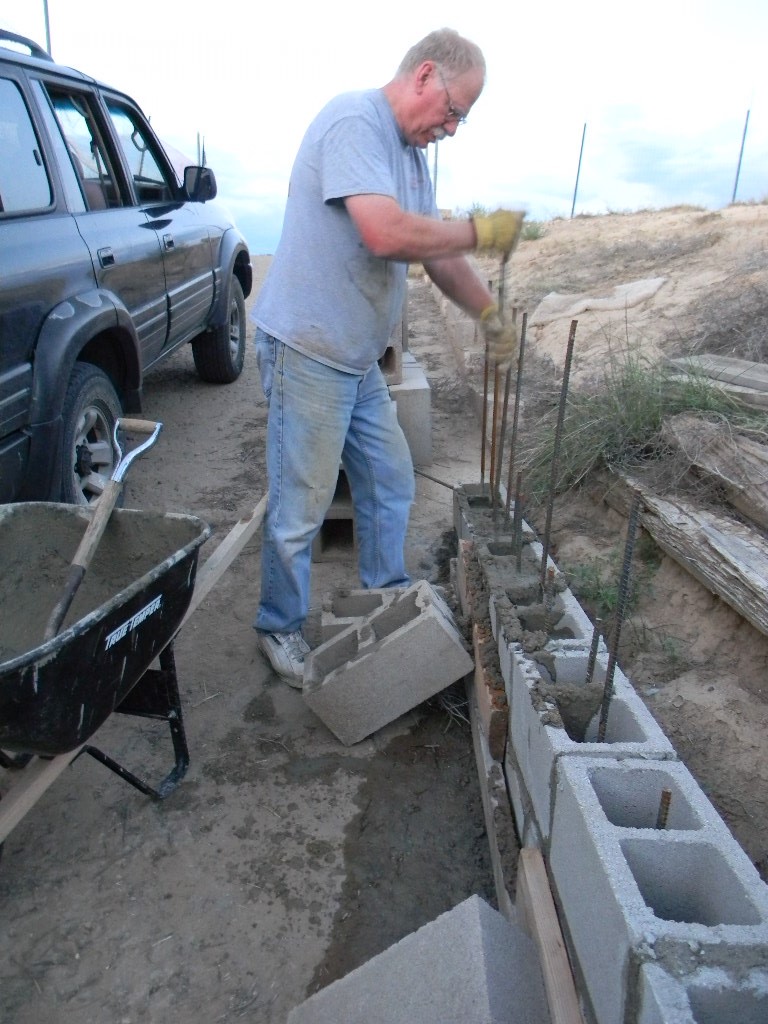

SpectraCyber observations with the 60-foot antenna
Rich brought the SpectraCyber 1420 MHz Hydrogen Line Spectrometer, to follow up on the successful observations we started to make with the 60-foot antenna during our Open House 2 weeks before. We used the System 1 pointing system. I later joined him by mid afternoon, after I finished my other work, and this is a report of what we did.
We started by searching for several sources with flux density values higher than 200 Janskies. However, at first no sources were found. The plane of the Milky Way was at that time very low along the southern horizon. There were few strong sources on our list available to look for at that time.
A little later, we just about ran into the Milky Way without looking for it, when the galactic plane rose higher. The signal trace of the SpectraCyber indicated the change: pointed away from the galactic plane, the signal trace stayed near about 3 volts, varying probably with noise, but not by more than a volt. Once pointing at the galactic plane, the voltage trace increased from about 5 to 7 volts (up to about 4 volts above the noise floor). The signal consistently showed a peak at about the center of the trace, at about the frequency of neutral hydrogen. We have not calibrated the SpectraCyber, and so we don’t exactly what frequency we were peaking. (The actual spectral line frequency is 1420.40575 MHz. And we may be seeing some doppler shift in our measurement.)
We then looked for several strong sources in the Sagitarius region, which by then had risen. We successfully found several, including:
- Sagitarius A, the center of our Milky Way galaxy. The radio emission is thought to be from the secondary effects of a black hole there.
- CTB 37, a supernova remnant about 20,000 light years away (see https://www.nasa.gov/mission_pages/chandra/ctb-37a.html.) Our signal trace showed three peaks through most of our scans. Our interpretation is that the central peak is the original supernova remnant. The other peaks would be the doppler-shifted material outflowing away and towards us, following the supernova explosion.
- The Sagitarius Star Cloud Messier 24, with a colder hydrogen cloud closer along the line of sight that absorbs some of the M24 hydrogen signal. This is the radio source Tony Bigbee pointed to during our Open House 2 weeks earlier. The signal trace has a distinctive dip, which had been identified in data from the Parkes Observatory in Australia. And as Tony has discussed, was used in the past by the RASDR2 team as an engineering detection test. The dip in signal is interpreted as a hydrogen cloud along the line of sight that is colder than the background source. It absorbs the background signal and then reradiates it out, but in all directions, hence the net signal to us is reduced. We used the RA & Dec location coordinates recorded during the Open House. We found the source again without difficulty.
We used the System 1 computer display to read the angles our 60-foot antenna was pointed to. The display showed coordinates in both azimuth & elevation (Earth ground reference), and Right Ascension & Declination (celestial sky coordinate reference). We turned the antenna with the manual steering controls. At this time we do not have automatic tracking ability. But we were able to reasonably stay on our targets with continual manual adjustments. What we more often did was we found our source, then allowed the antenna to scan at the set elevation as the Earth rotated, and as a result get a short scan along a line of Declination. We then moved the elevation up and down slightly, to see differences in the scans a little north and south. We used this technique also to hone in on targets.
We then manually scanned across the Milky Way galactic plane, to obtain a slice from 16 to 20 hours Right Ascension, along the declination of -05 degrees. We stopped at intervals of 30 minutes Right Ascension (e.g., 17h 00 min, 17h 30 min, 18h 00 min, …), to let the SpectraCyber take full scans.
Our scan cut a steep acute angle through the width of the galactic plane, going across the constellations of Ophiuchus, the north edge of Scutum, and the southern part of Aquila. We therefore started and ended at angles pointed “above” and “below” from the galactic plane, and scanned across the galactic plane in between.
Since we were pointing to the southeast (and not due south), if we moved azimuth while maintaining elevation, the declination still changed. And so to keep on the -05 degree declination line, we had to adjust azimuth and elevation together.
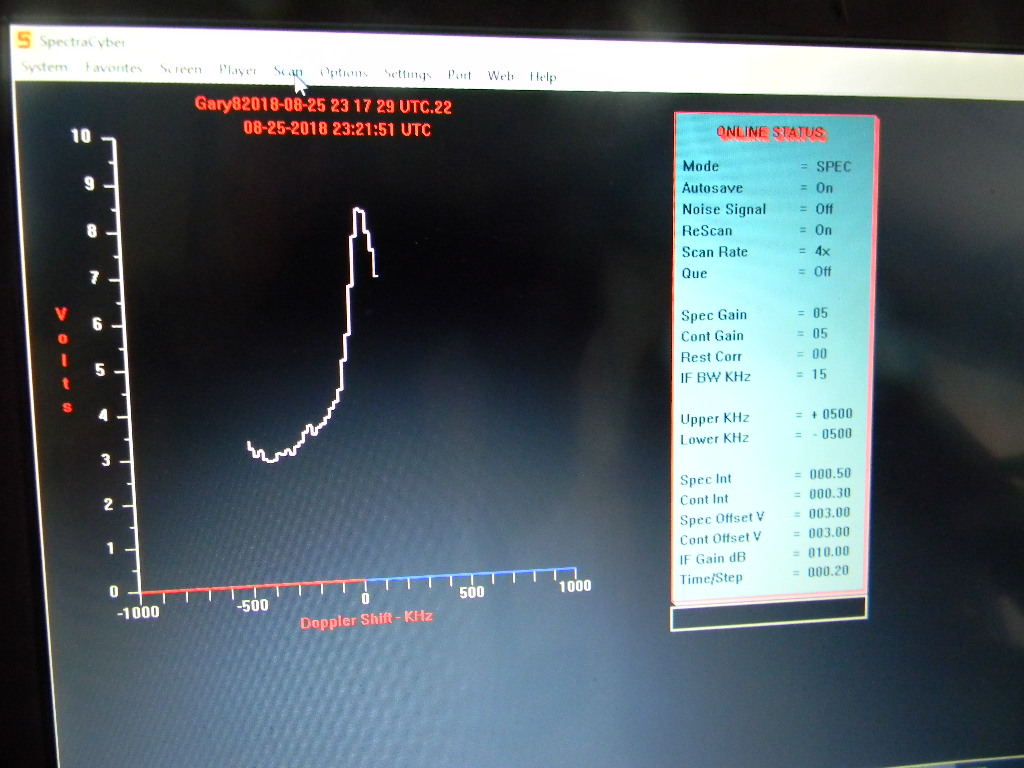
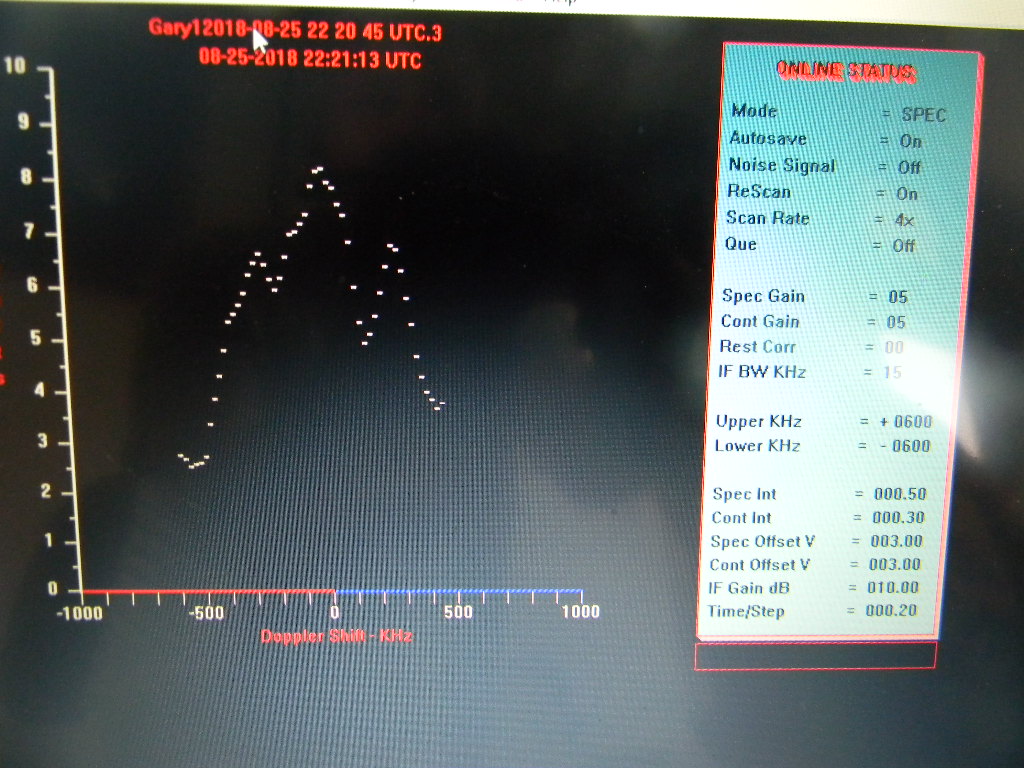


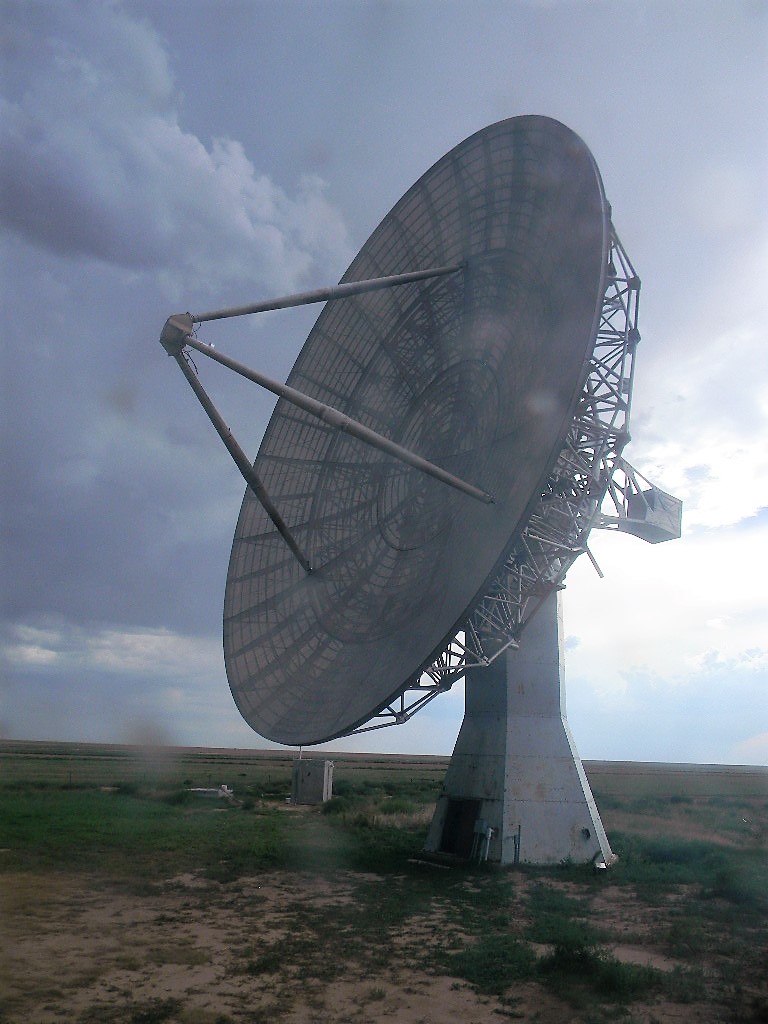
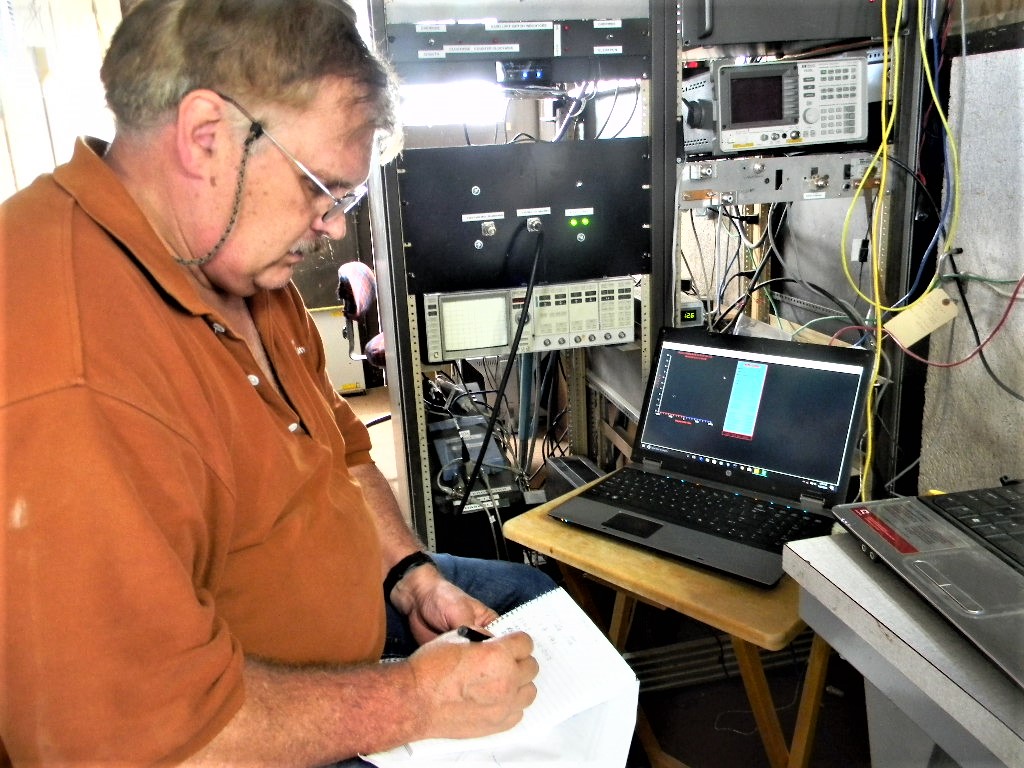
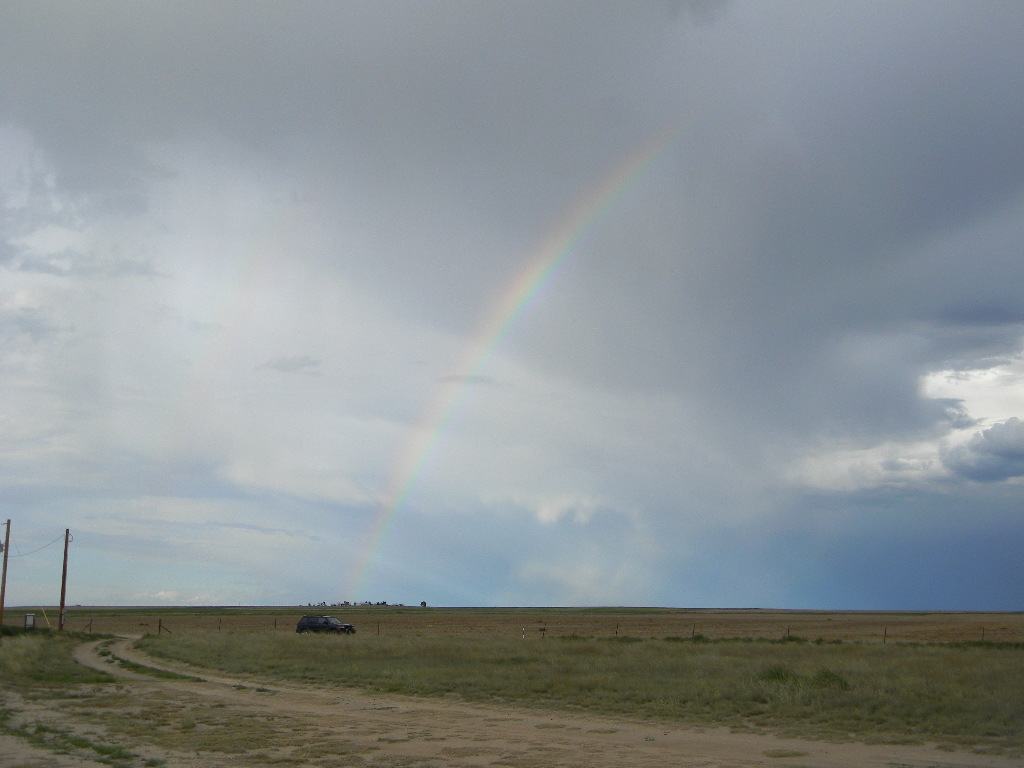
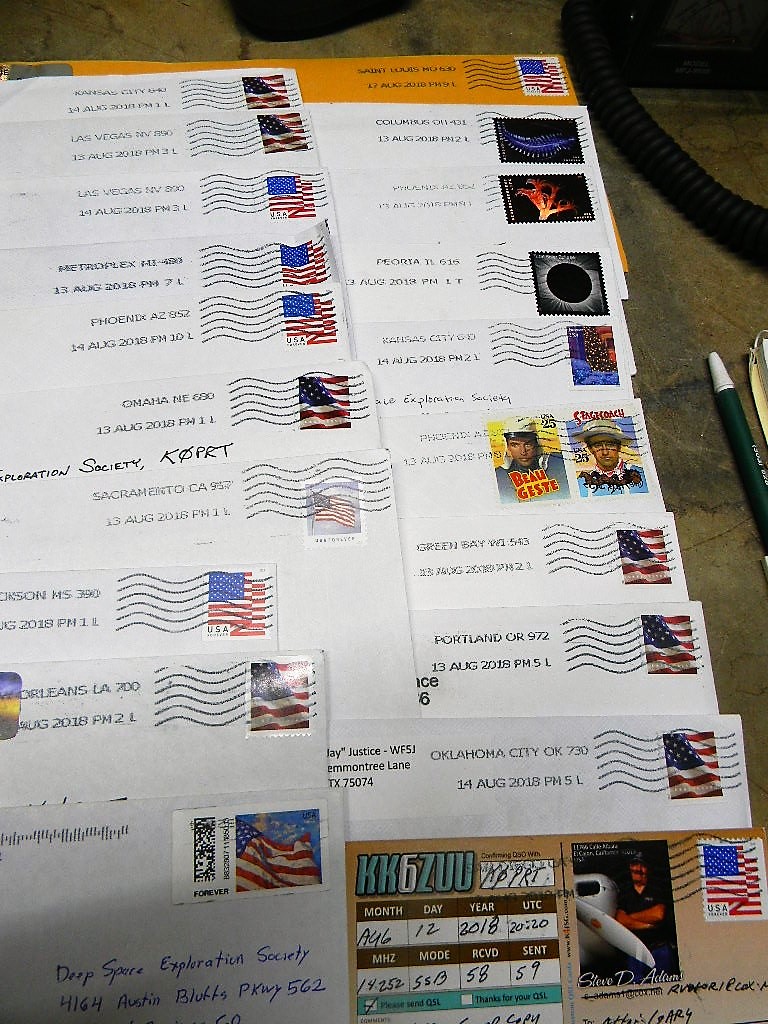
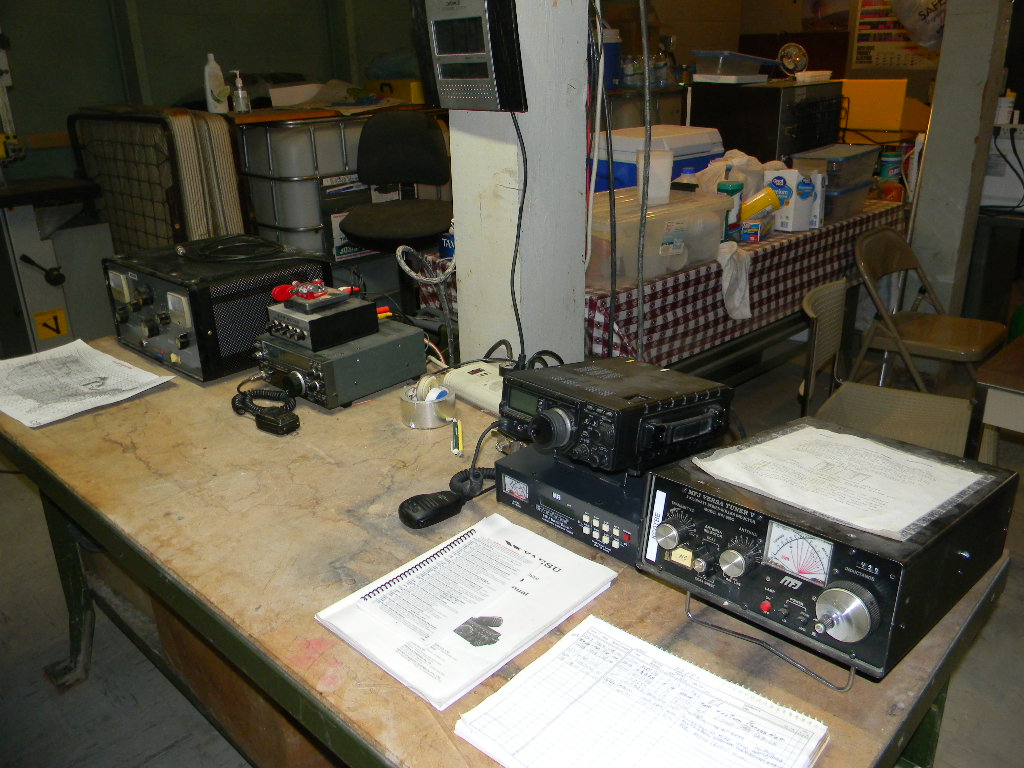
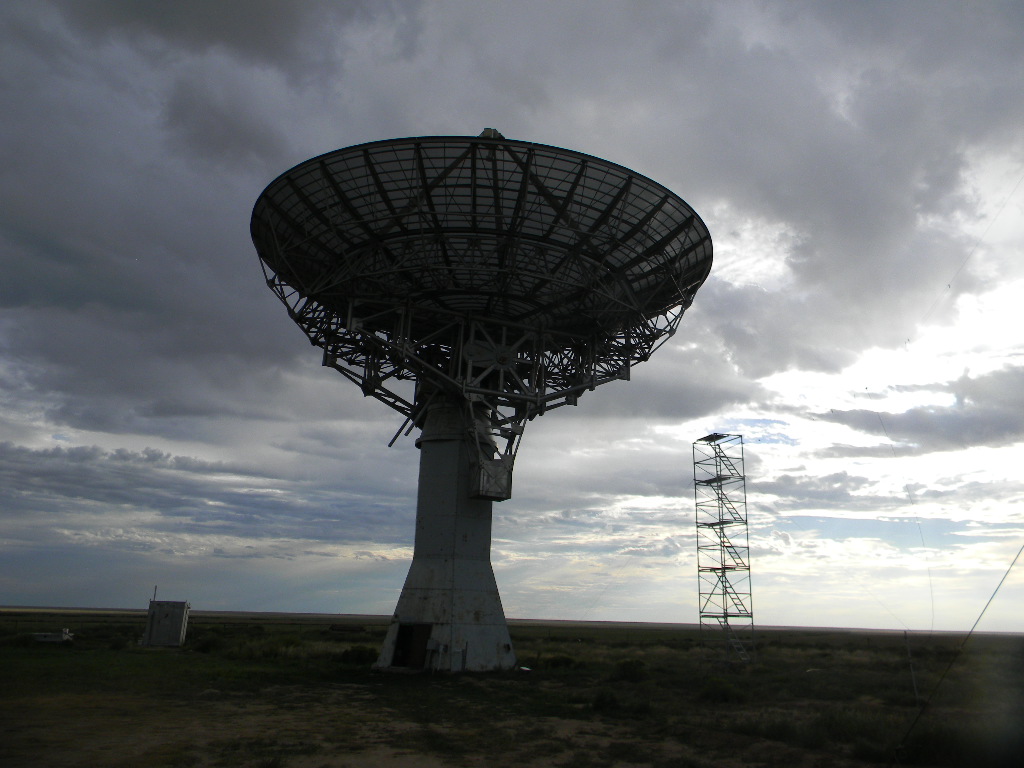
DSES Science Meeting August 27, 2018 Follow Up
On the following Monday we had our monthly DSES Science Meeting at the home of Rich Russel.
At the meeting we discussed the observations we made with the 60-foot antenna two days earlier.
Tony Bigbee then also presented deeper details about his RASDR4 (Radio Astronomy Software Defined Radio). And he gave us more background about the earlier RASDR2 observations of Messier 24, with the dip in frequency. And he showed how he researched the earlier Parkes observatory data to find useable results and plots for us to compare to.

– 73, Gary Agranat, WA2JQZ
DSES Technical and Operations Meeting Minutes 8-13-2018
Please click to open and read the DSES Engineering Meeting Minutes of August 13, 2018. – Bill Miller
Telescope site trip report for Saturday July 29, 2018
Work trip report by Bill Miller.
Plishner Radio Telescope Site Work Trip, July 20 -23, 2018
Trip report and photos by Gary Agranat and Bill Miller, with contributions from the rest of the team.
We traveled to and worked at the Plishner radio telescope site during the weekend of July 20 to 23, 2018. Attending were: Steve Plock, Ed Corn, Paul Berge, Bill Miller, Dave Molter, Gary Agranat, and Tony Bigbee. This is a summary of what we did:
– The site received several days of heavy rains during the previous week. The bunker sump pumps were overwhelmed and the bunker was flooded. Steve and Paul spent a number of hours on Friday and Saturday morning clearing out the water and cleaning up. Steve reported clearing at least 60 gallons of water. Dave later on Saturday also spent time removing water and cleaning. Paul cleaned up some more water on Monday morning.
– On Saturday morning Paul and Bill filled in the conduit trench for the synchros.
– Ed installed a conduit and the power cables from the pedestal to the outhouse. He also started to install the cables from the outhouse that will lead to the RV power risers and connections. Ed said he intends on the next site trip to put in breakers, extend the wires to the RV locations, and install the outlets there.
– Paul put in wiring to the limit switch system, for azimuth and elevation limits of the dish travel. Paul stayed over Sunday to complete more of this.
– Paul and Bill installed the synchro indicator panel and reinstalled the manual dish steering control panel in the rack, in the com trailer. The panels in the rack will still need to be moved down one U space, to accommodate Skip’s TM-4 timing control. The Spectrum Analyzer was moved over to the adjacent rack. Paul installed the limit switch control panel under the manual control panel in the rack. They redid the panel configuration so that all the panel controls have azimuth on the left and elevation on the right to match convention. Bill relabeled all of the control panels to provide a more organized presentation of the switch and knob functions.
– Bill brought out the System 2 dish controller and laptop. It had worked well on the bench at home, but at first didn’t work at the site. After some frustration he called Ed Johnson and they worked through the problem. The static IP address of the computer had to be set and then the system communicated and could be tested. Paul stayed in the tower control deck while Bill drove the dish from the comm. trailer. A fairly serious problem was found and Ed was consulted again by phone. The watch dog timer was apparently timing out and dropping the power to the motor drives about 3 times a second. Seeing this they immediately shut it down. Bill took the system home to do a modification on the VFD power enable relay and to trouble shoot the reason for the time out. Once fixed, he will bring it back for more testing. Bill informed Dave Molter of the problem and asked that he not repeat the same issue in the motor drive control circuits of System 1. Bill also provided Dave with a linear power supply and some parts to complete System 1 controller.
– Bill also installed the latch on the System 2 Controller and temporarily installed the DB25 switch boxes in the control deck so we can switch between systems for test and maintenance.
– Steve and Gary worked on installing the MFJ auto-tuner for the FT-897 ham transceiver in the bunker. They found that the tuner would not power up, although the manual indicated that it should have. There is an alternative way to directly power the tuner, but they didn’t have the proper wiring. Steve gave Gary a wire on Monday, which can be used to connect the tuner directly to the power supply (located lower on the bench below the rigs). Gary also brought the mini-manual for the FT-897. It is like a checklist, and is useful for quickly finding menu settings.
– Gary used Dave’s antenna analyzer to check the SWR across the ham bands for the 5-BTV vertical antenna we installed by the bunker. The results show that the 10 and 15 meter bands are tuned well. The 20 meter band is biased towards the low end, with 14.0 MHz at an SWR of 1.4 and 14.350 MHz at an SWR of 2.8. The 40 meter band is biased towards the high end, with 7.0 MHz at an SWR of 3.1, the minimum of SWR 1.5 at about 7.23 MHz, and 7.3 MHz at SWR 1.8. 80 meters is tuned to a best frequency of about 3.9 MHz (SWR = 1.8), with a probable usable range from 3.87 to 3.947 MHz (where the SWR reaches 3.0). Gary noticed one of the smaller radials for the vertical broke in the middle. Perhaps it had been set a little too tightly.
– After checking with the analyzer Gary did some operating through the afternoon and evening on 10 through 40 meters, mostly on FT8 digital mode and some SSB on 10 meters. He was able to tune on the digital portion of all of those bands with his FT-950. During that time he made about a hundred contacts, which give the club some exposure to the ham community. As of this writing, about 50 confirmations were received on LOTW and eQSL. The QRZ page counter increased by about a hundred during that time as well. Propagation was poor, so that most contacts were just around the US. We did get some DX to Germany, Italy, and New Zealand. Gary also checked into the 12:30 pm Weather Net on 146.970 MHz on the Pikes Peak repeater, which is at a distance of over a hundred miles.
– Dave Molter brought his trailer out and the crew loaded up most of the remaining surplus wood container parts for Dave to dispose of.
– Tony Bigbee came out for the first time on Sunday. Bill gave him a tour of the facility and Tony went right to work, cleaned out the pedestal base room, and sorted out a lot of the surplus hardware there. Thanks Tony, this was greatly needed.
– The Britain family from Haswell came out on Sunday afternoon. Bill, Paul, and Tony gave Mr. and Mrs. Britain and their two ~10 year old boys impromptu presentations and tours of parts of the facility. Mrs. Britain is a teacher and very interested in working with DSES on a school & student outreach program in the area.
– Dave again tried the VHF talk-in radio system (on 146.46 MHz) while coming in to the site. We had a clear contact with him from about mile marker 128 on Highway 96. Gary tried communicating through the talk-in system coming from the south from Las Animas. He contacted Ed and could be heard from the first transmission at the county line, which is on a ridge. Gary again tried talking to the system with Bill while going out, traveling north to Haswell and then west on Highway 96 past mile marker 128. Gary could hear Bill clearly along most of the route, but Bill had some difficulty hearing Gary. Bill suspects the problem may be at the audio of the phone receiver in the comm. trailer.
The team considered this a successful trip.
PHOTOS:


Gary using Dave’s antenna analyzer to record SWR (standing wave ratio) values on the 5-Band Trap Vertical antenna for the HF ham frequencies it covers.
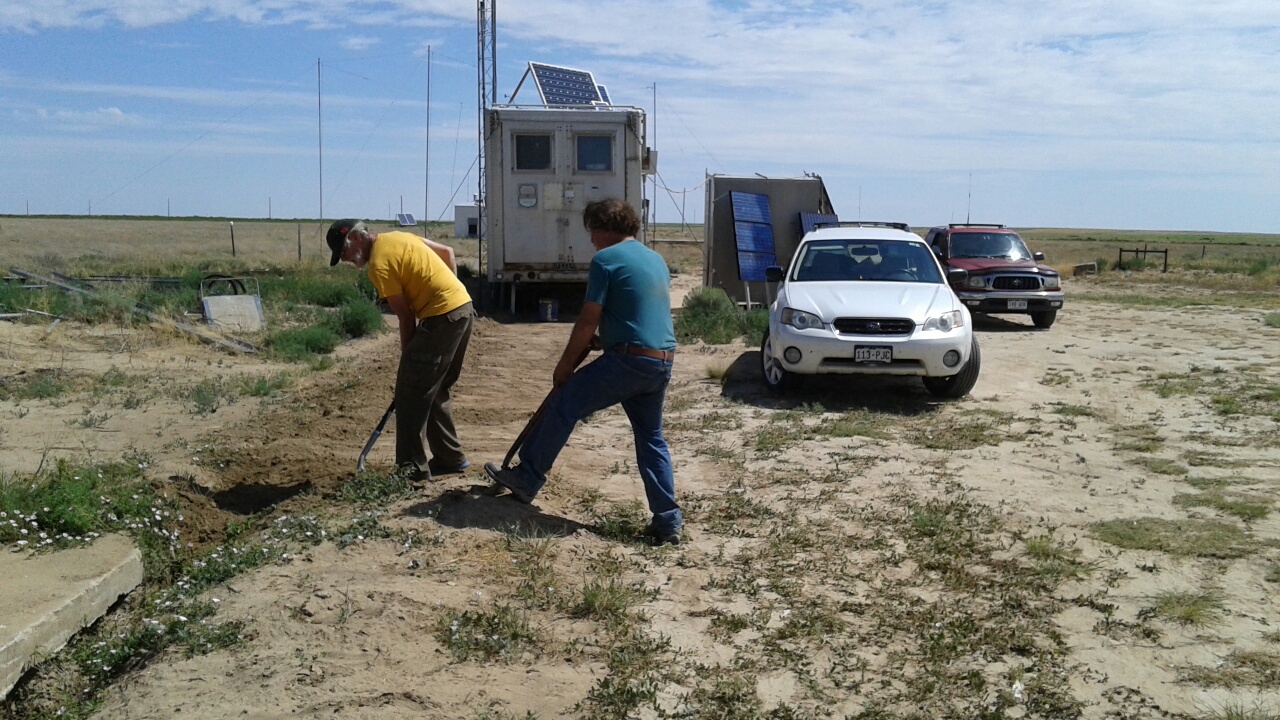
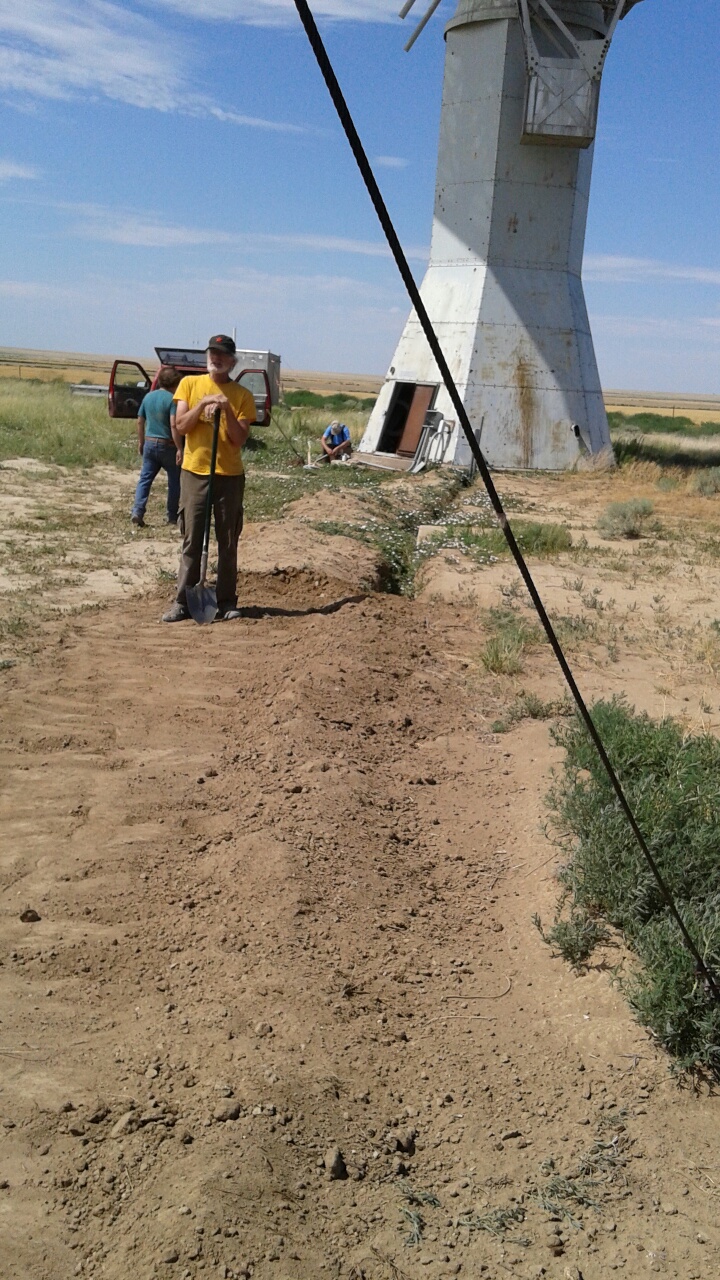
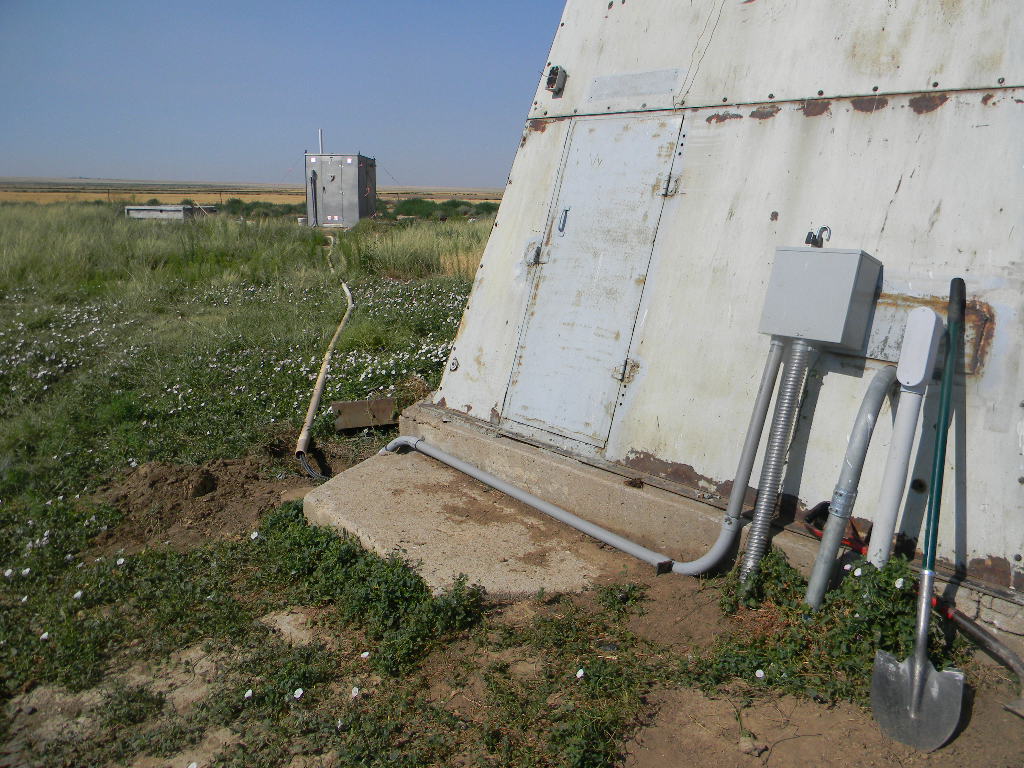
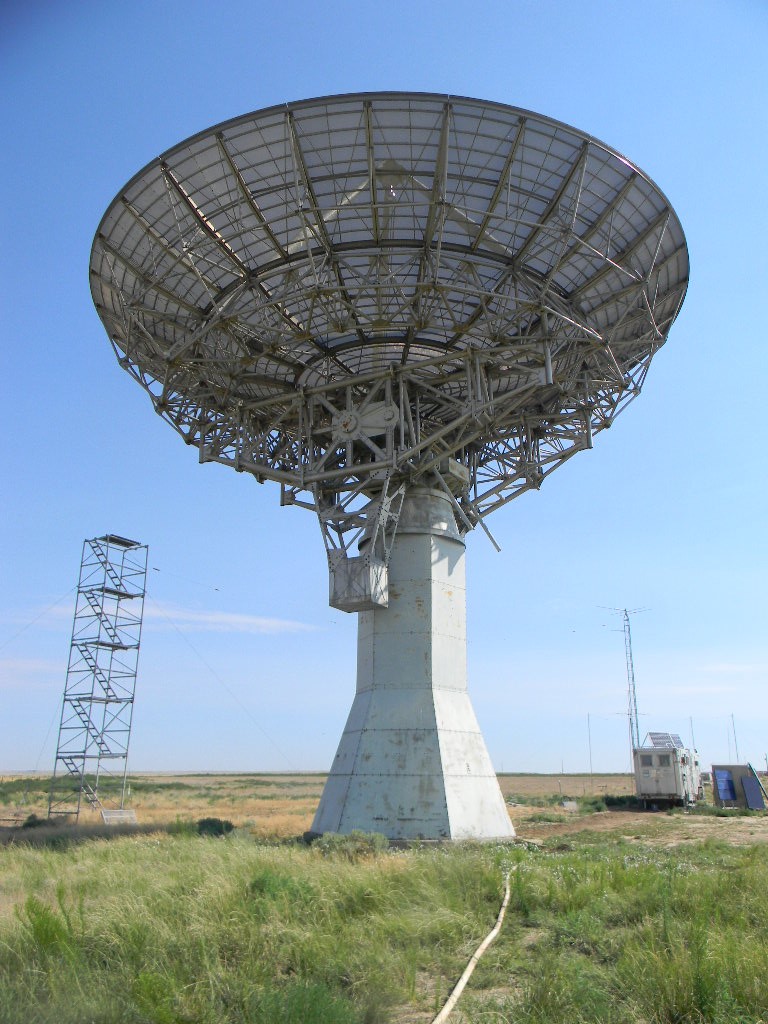

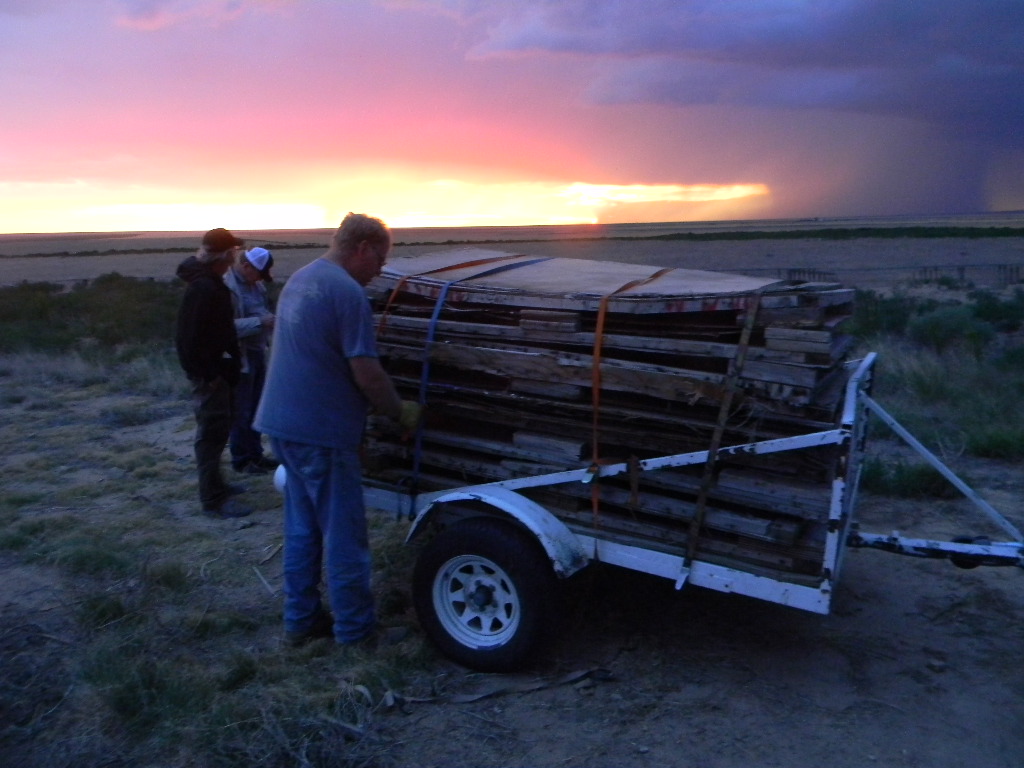
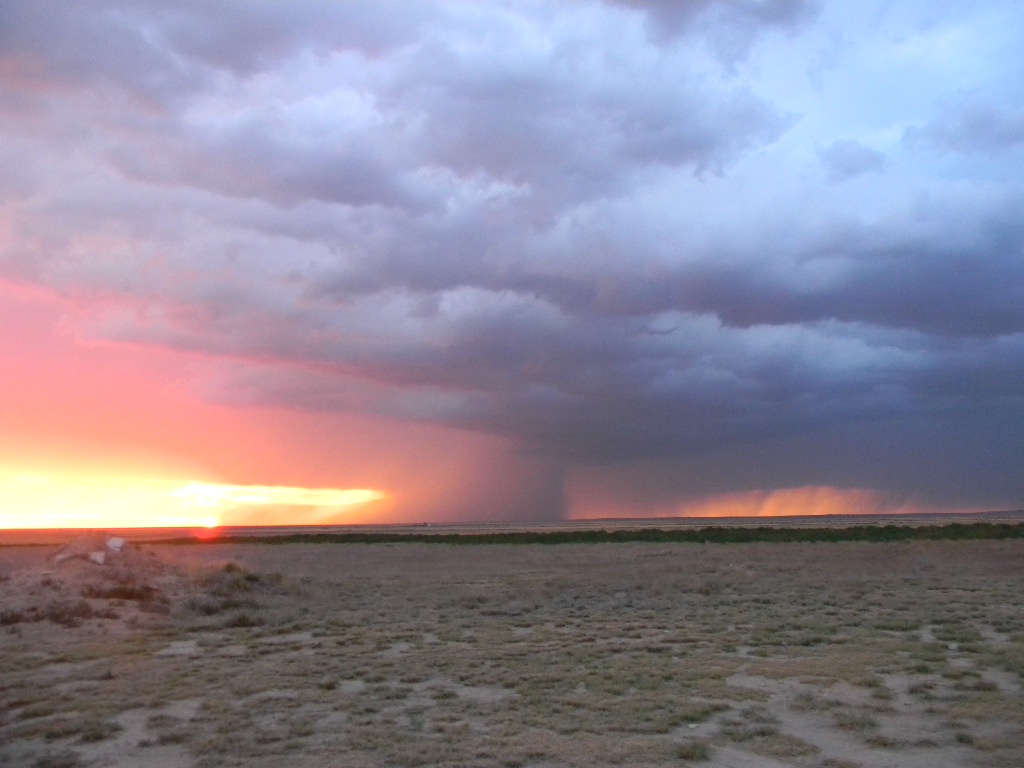
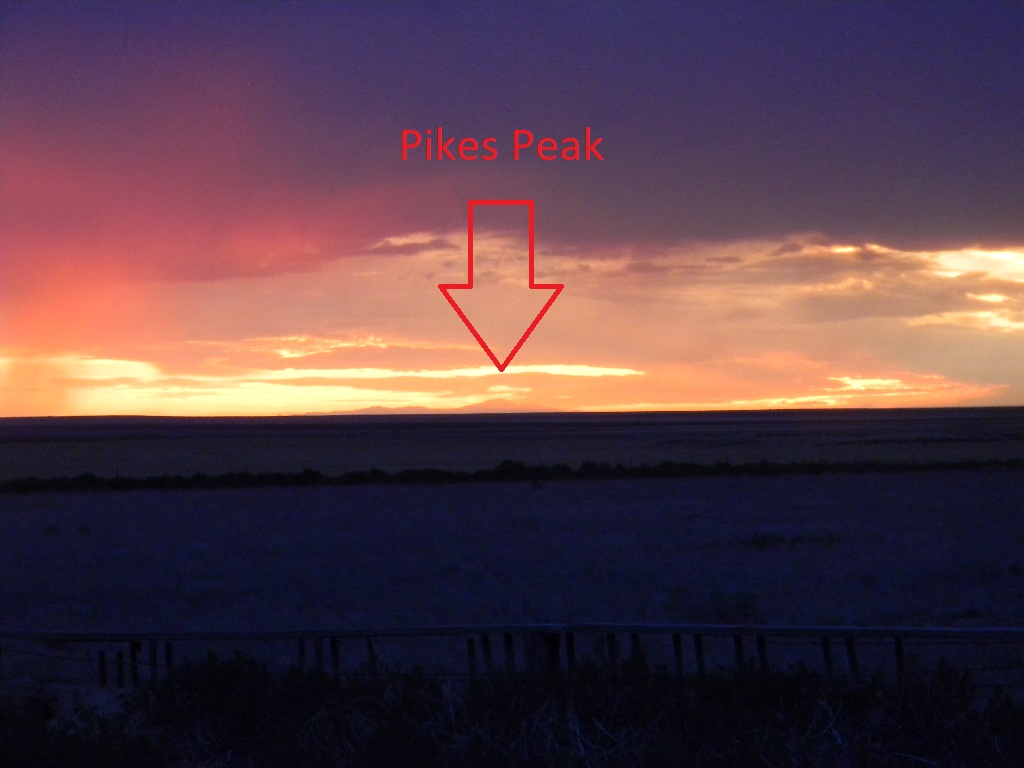
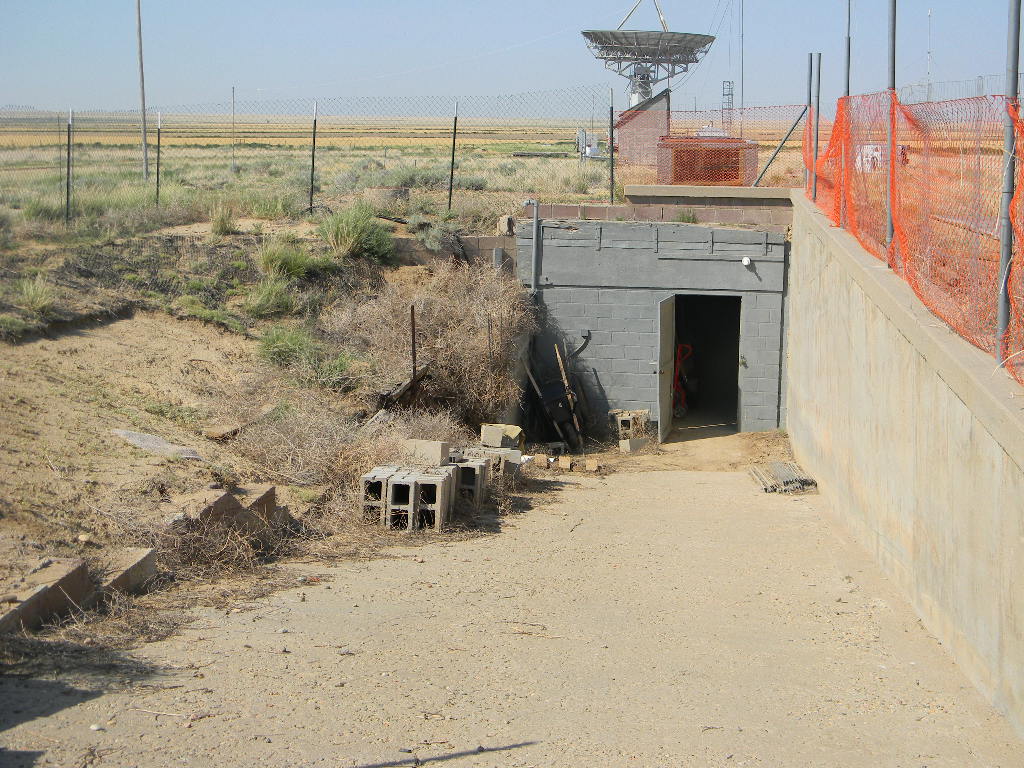

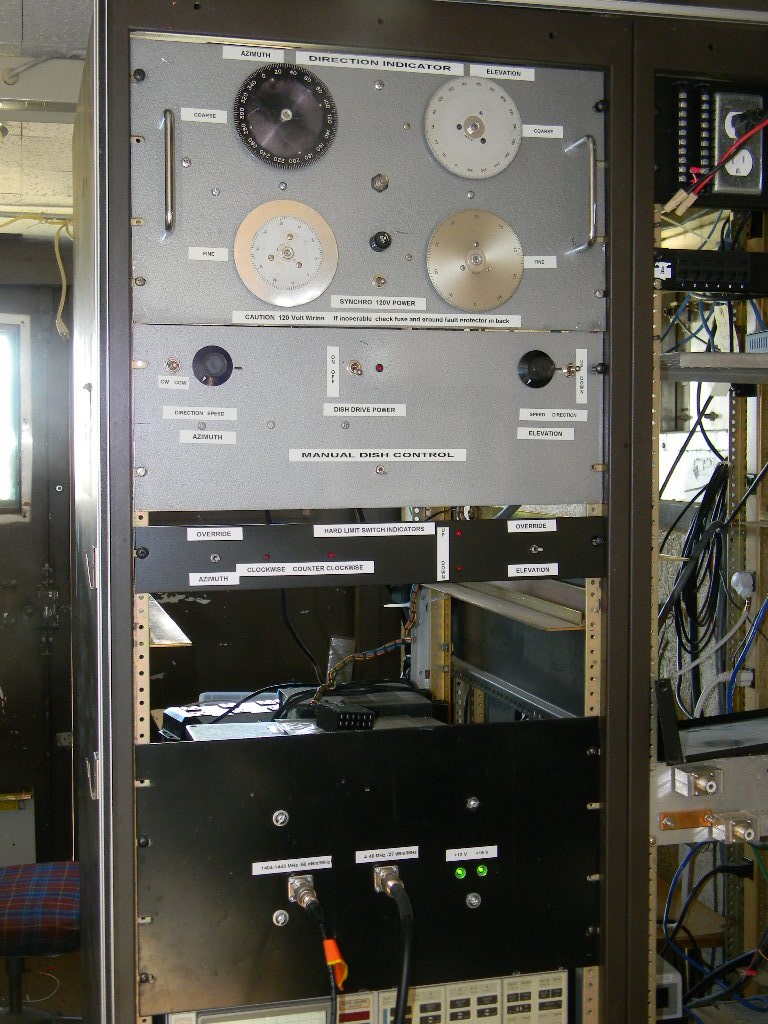
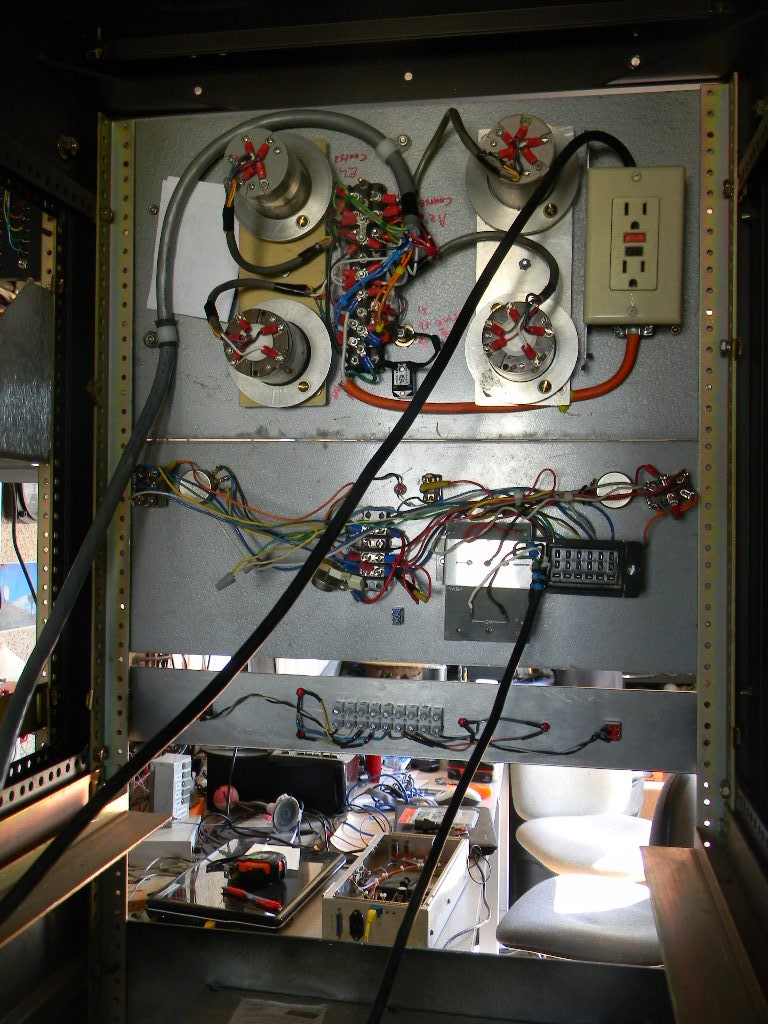
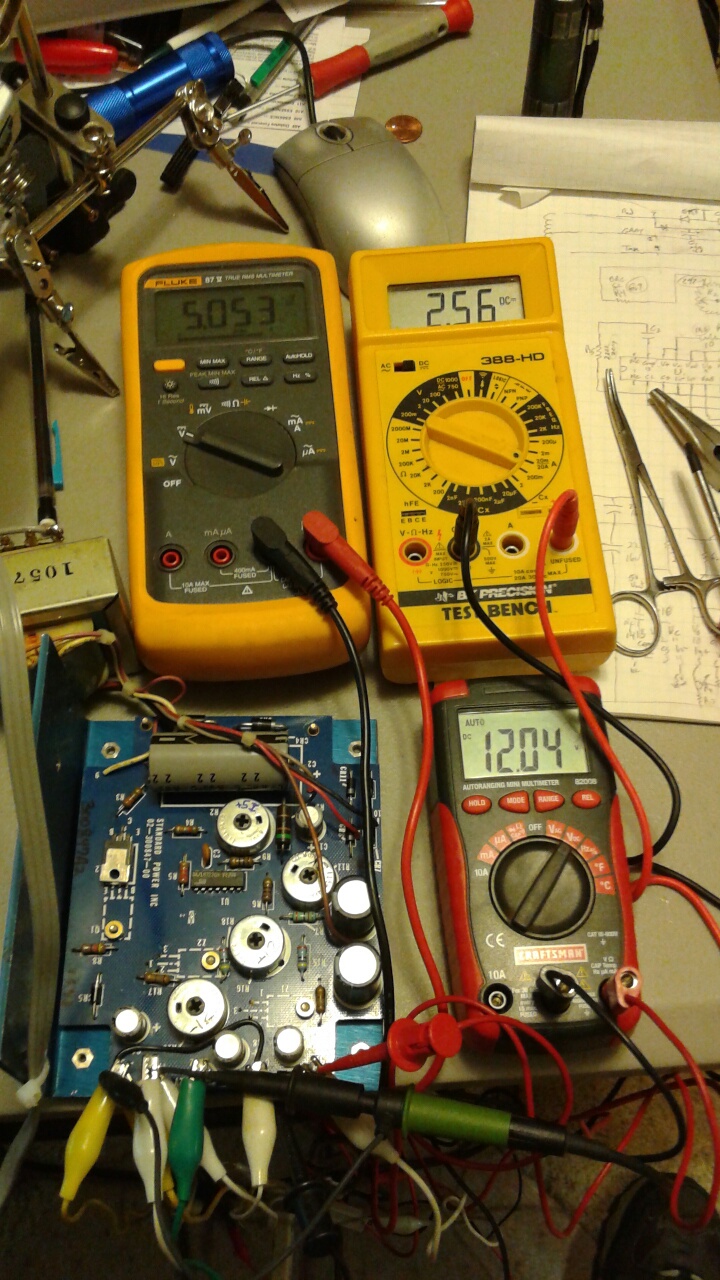

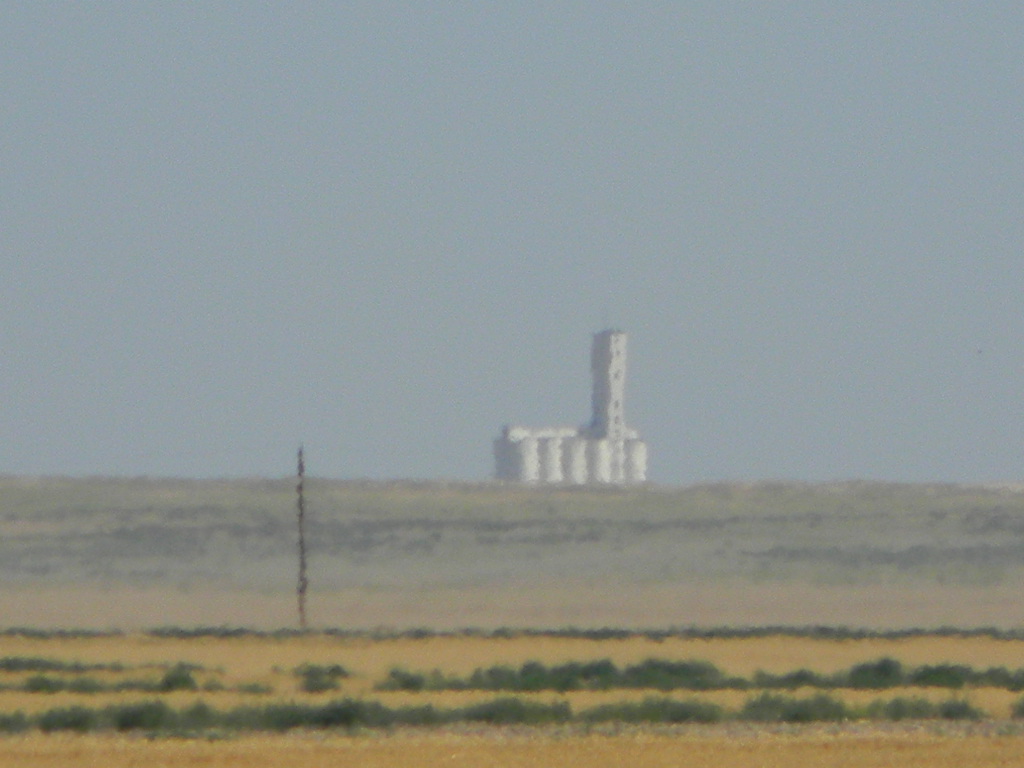
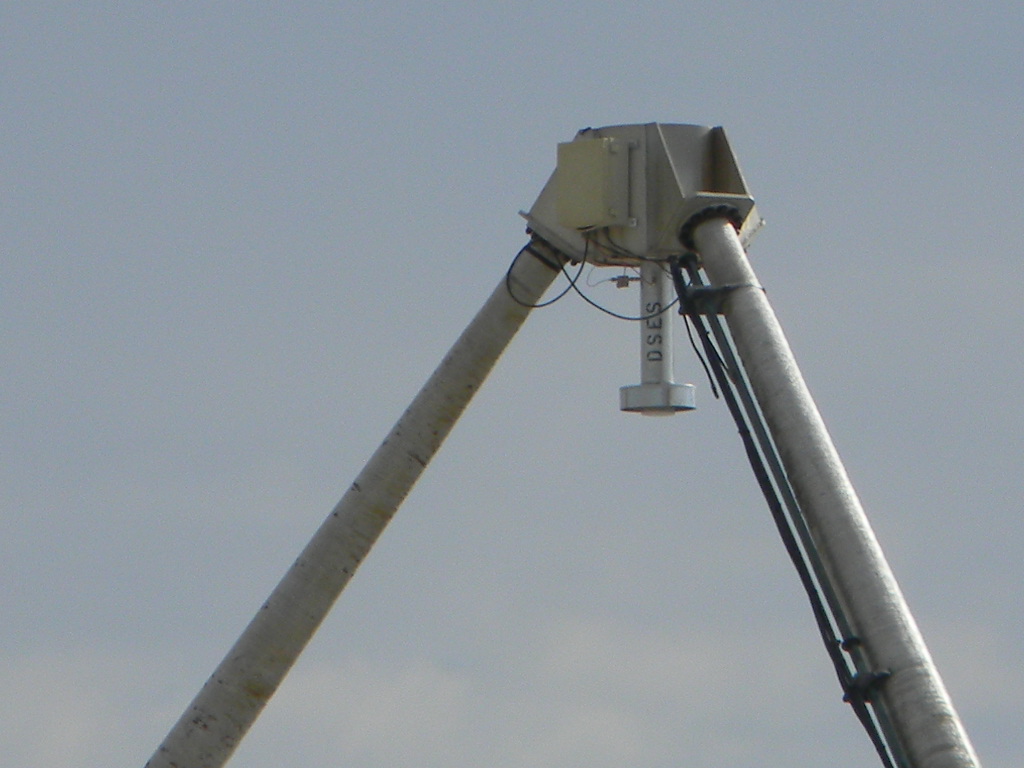
Plishner work site trip, June 16 & 17, 2018
Trip report by Bill Miller, with editing and photos by Gary Agranat.
This is a report of our work at the Plishner radio telescope antenna site during the weekend of June 16 & 17, 2018.
Attendance: Gary Agranat, Paul Berge, Ed Corn, Michael Lowe, Bill Miller, Dave Molter, Steve Plock.
Vertical Multi-band Antenna Radials: Gary performed a set of SWR (Standing Wave Ratio) measurements with an antenna analyzer on the vertical multi-band antenna, which was installed last April for the ham radio station at the bunker. He then installed 17 radials at the antenna base. On the next trip he plans to retake antenna analyzer measurements, and also do some digital radio operating, to compare characteristics before the radials were installed.
New Rest Room: Steve Plock and Ed Corn continued work on the new rest room/out house. This is a refit of one of the rail road buildings previously used for storage. They added tie down cables to prevent it from succumbing to the winds. It will be fit with a chemical toilet and there is a waste receptacle behind the building for easy dumping access. This will greatly improve our facility for public visits such as the open house on August 11th.
Synchro Installation: Bill worked on the dish Az/El Synchro installation as a simple backup pointing system for the dish. On the previous trip Bill and Steve installed an additional 2” conduit from the Comm Trailer to the pedestal. Myron had helped pull in the 15-conductor cable. On this trip Ed Corn helped finish off the conduit and drilled 2” access holes in the trailer floor and pedestal. Bill installed the cable up the pedestal structure and terminated it in the terminal box above the control deck. He also terminated the other end on the synchro panel in the comm trailer. The azimuth synchros were hooked up and they worked. One problem remains with the fine azimuth synchro. The Elevation synchro connection on the dish will be made in a future trip.
Pointing System 1: Bill and Dave examined what would be needed to complete system 1. Bill has a linear power supply in the works to replace the noisy switcher. He also has an amplifier and watch dog circuit for the control function in progress. Dave suggested removing the system 1 box on the next trip and bring it back to Colorado Springs to install these and other software modifications for Glenn to test. Currently system 1 only has position feedback and no direct control.
Pointing System 2: System 2 currently has all the circuitry for full position reporting and tracking control. As reported last time, Bill is working to transfer programs between computers and working on the system 1 at home and will reinstall on the next trip.
Dish Restoration and Maintenance: Paul Berge came down Saturday afternoon and stayed for work Sunday. Paul checked our Synchro system and made some valuable suggestions. He worked on other maintenance items on the dish including making a rubber bellows and seal to keep the water and birds out of the multiple cables feeding down through the center of the azimuth axes. He also started working on wiring and setting up the Elevation and Azimuth limit switches.
Other Items: Dave Molter finished the tear out of the 12-foot fiberglass dish and support concrete from Sue’s yard in Sugar City. He transported it down to the site on his trailer and unloaded it for future use. Bill and Dave pulled a vertical antenna and base insulator out of the pedestal and loaded it on Dave’s trailer. Dave returned the antenna to Michael Lowe in Pueblo who originally brought it to the site.
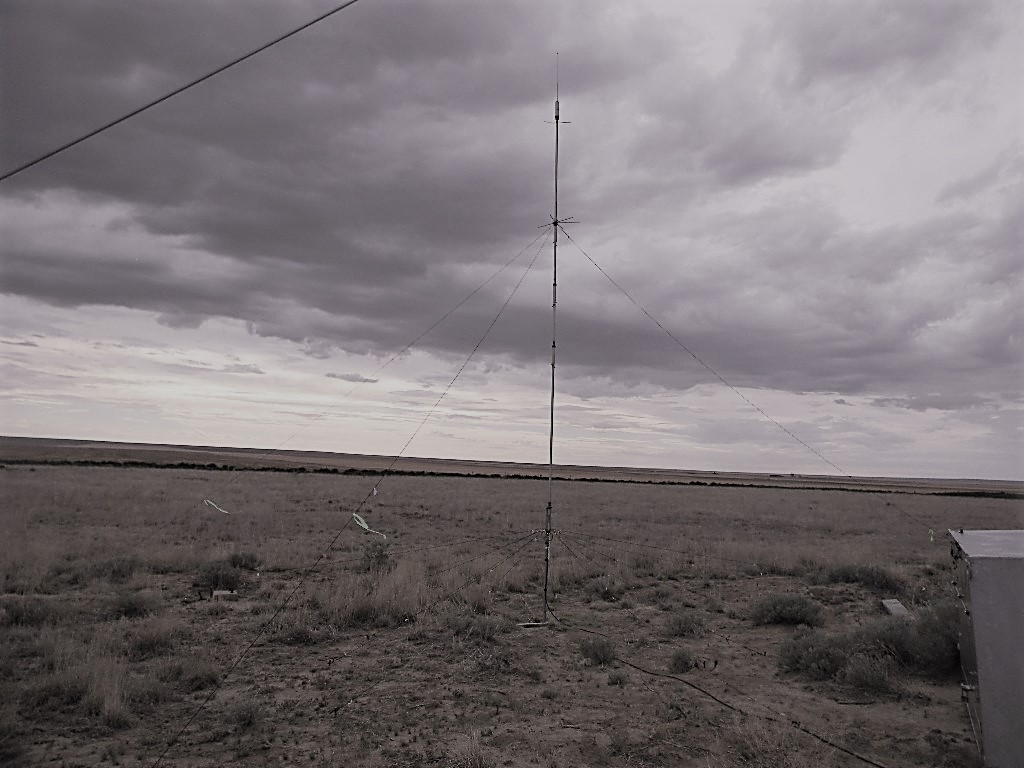
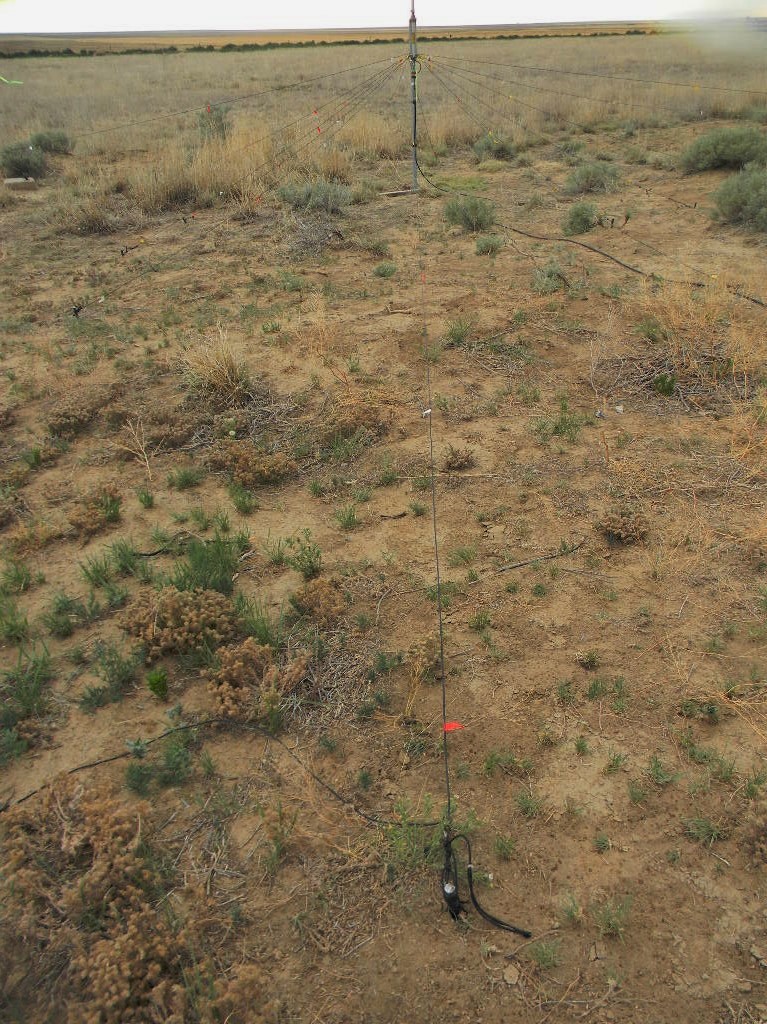
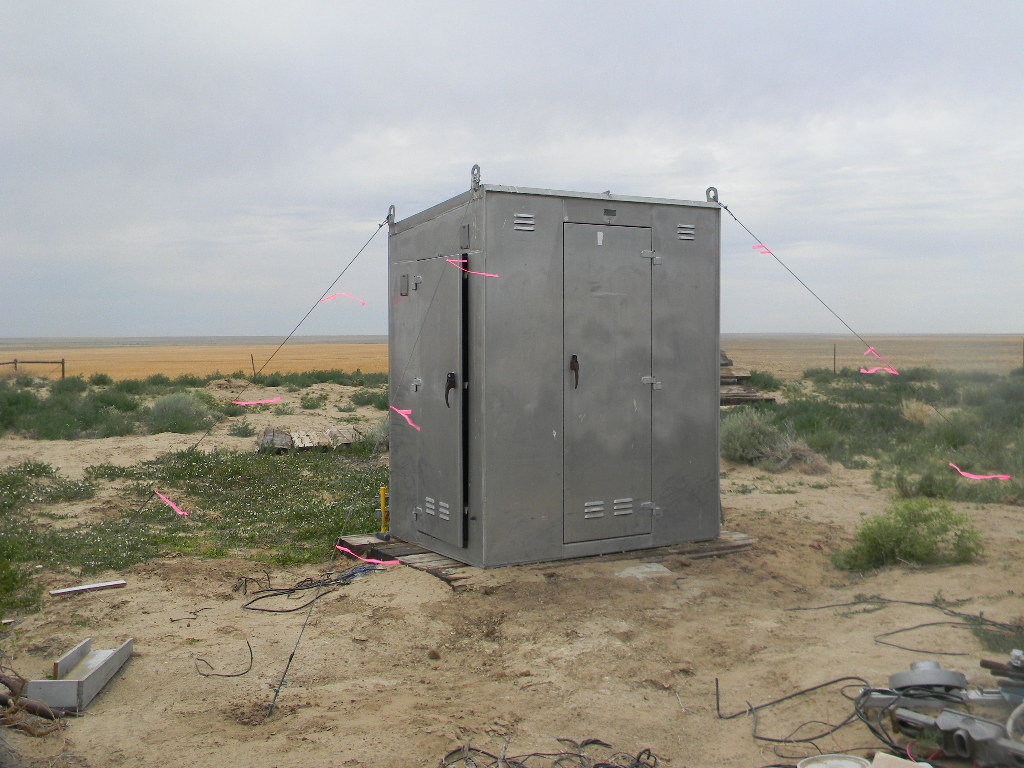
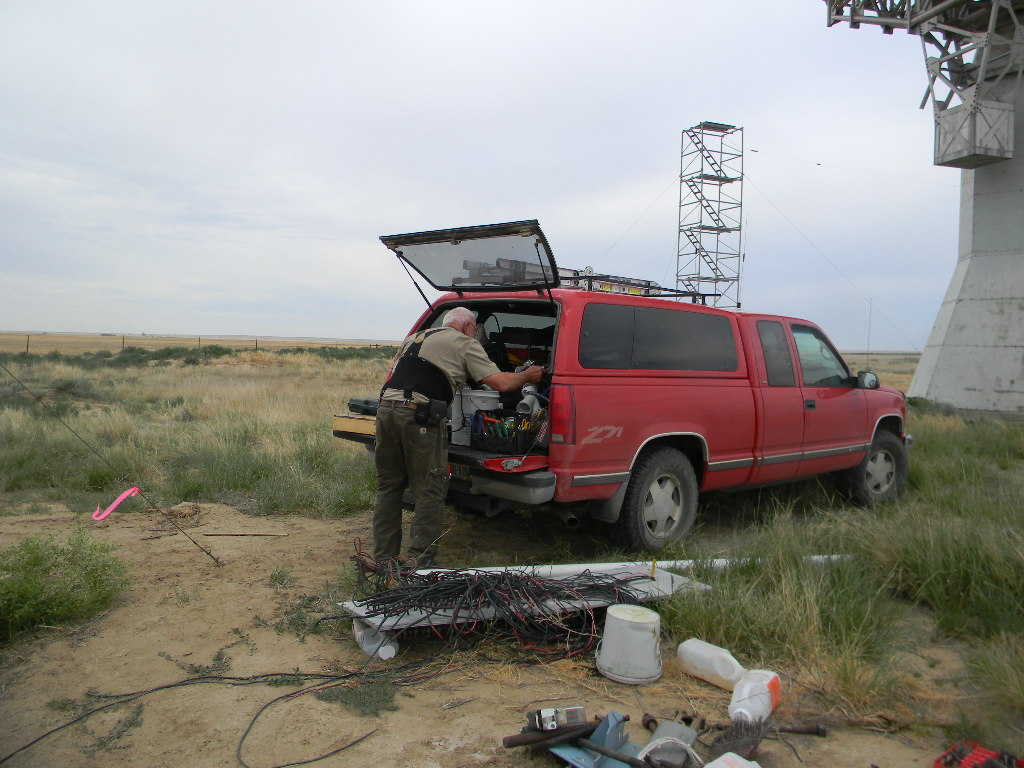

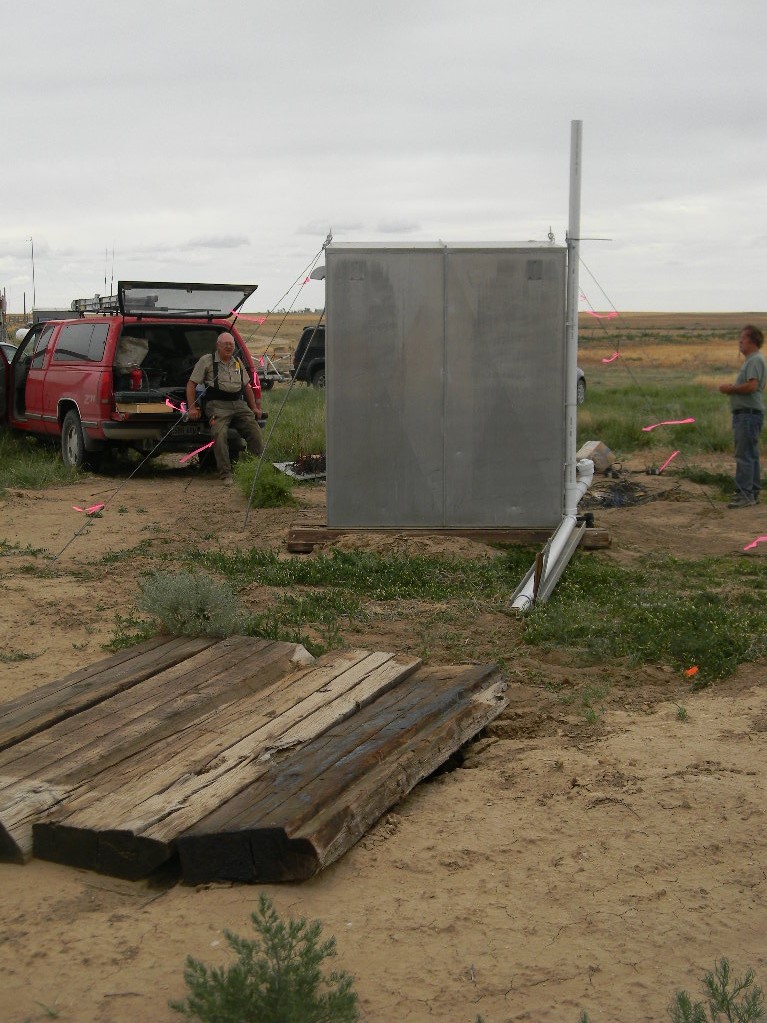
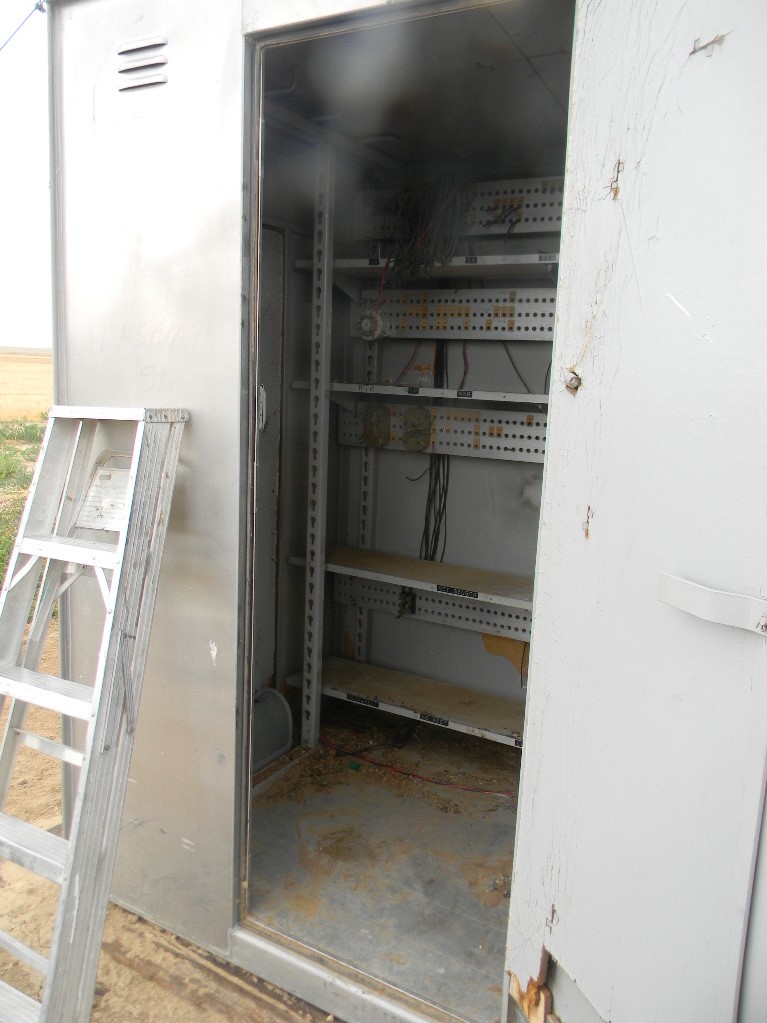

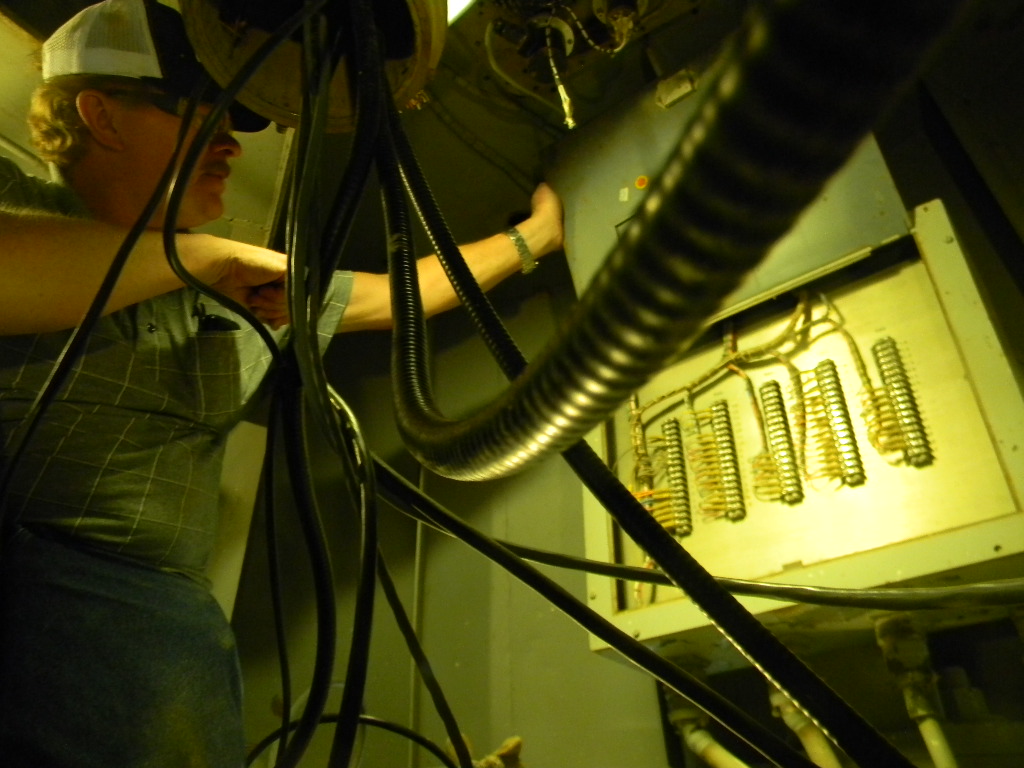
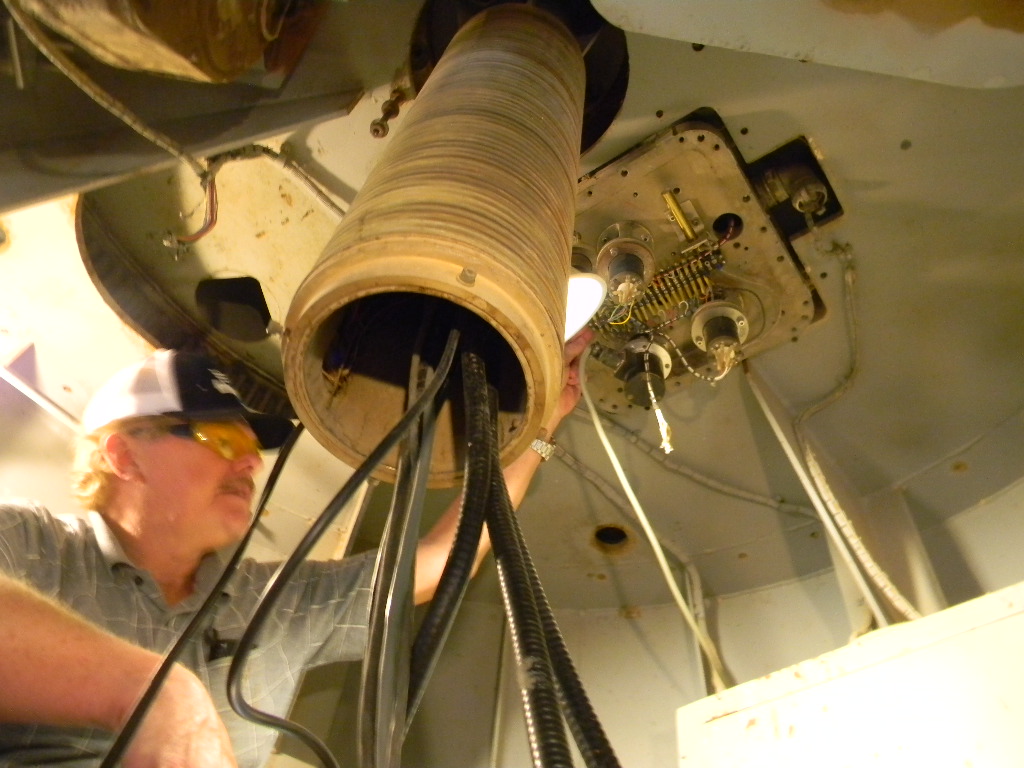
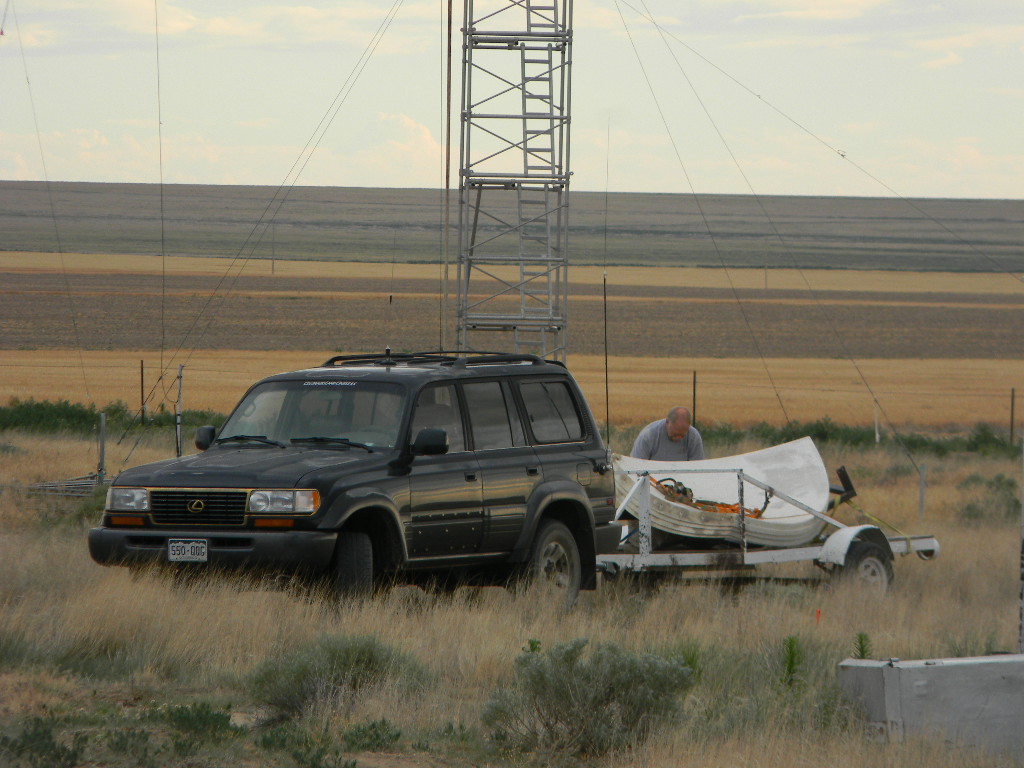
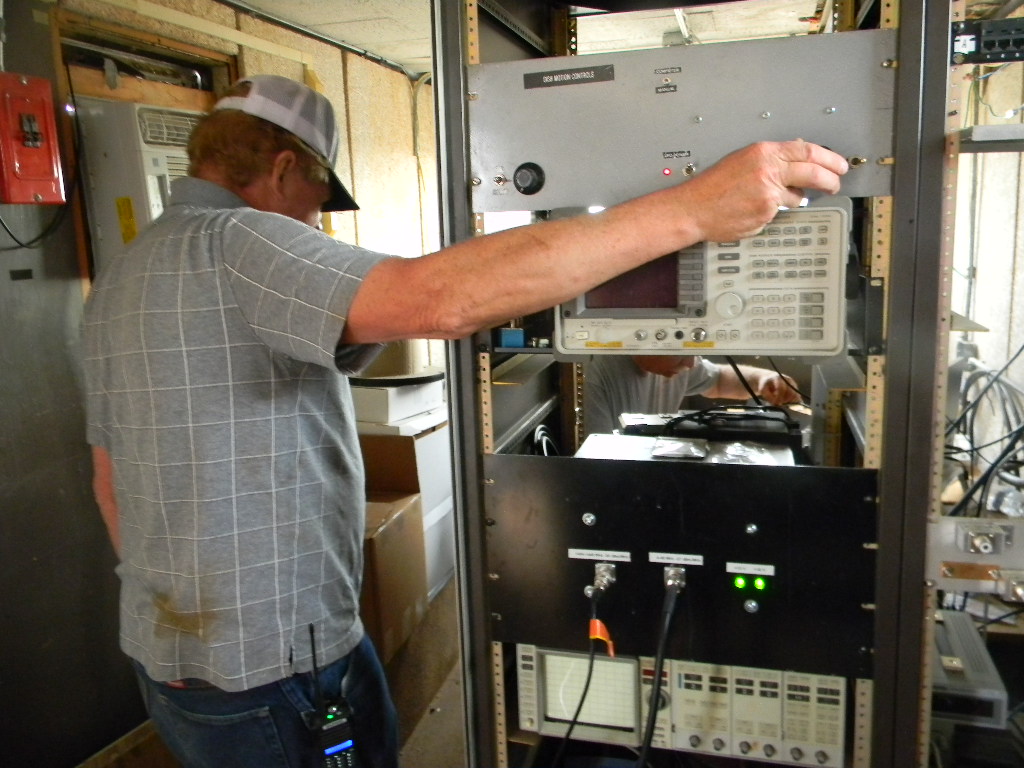

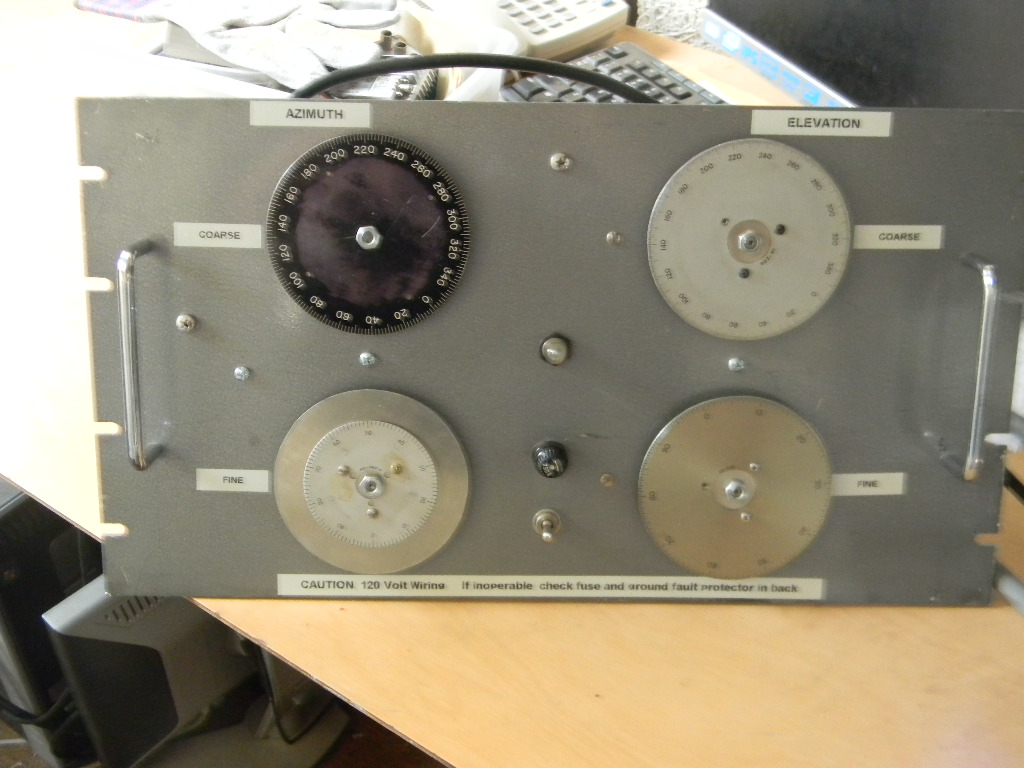
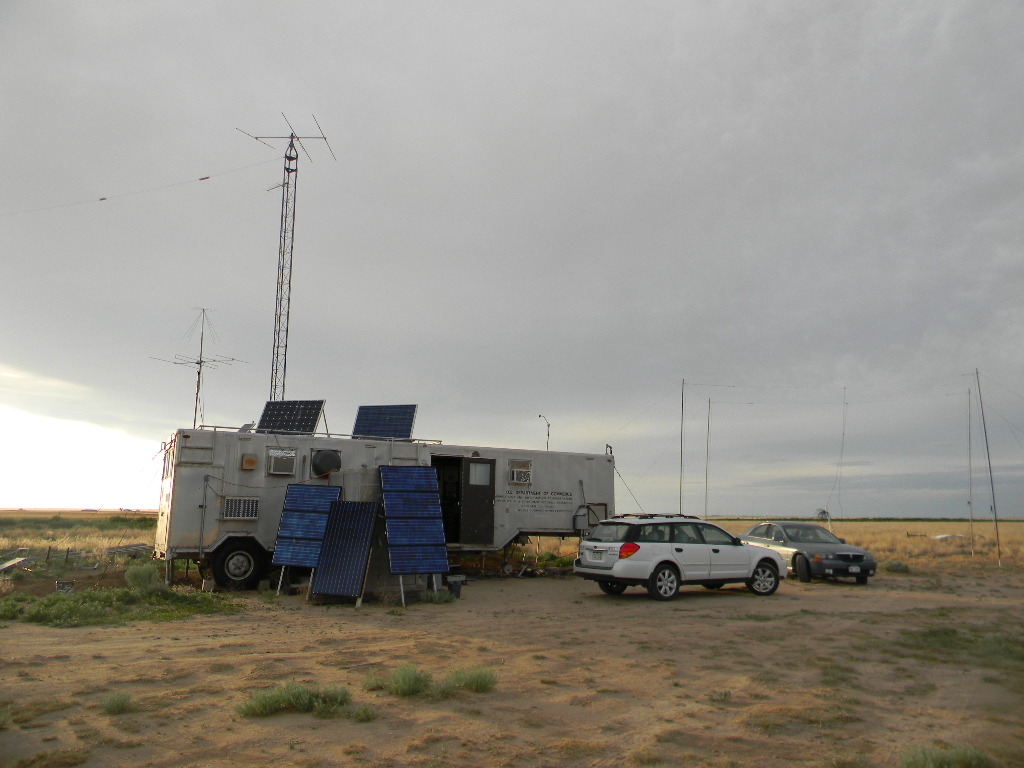
While we worked on Saturday, there was harvesting in the surrounding fields.

